Dallas-Austin
Feb. 8-9, 2012
Photos by Dave Ingles
| Having ridden the DART Green Line in entirety and with no other urgent DART light-rail line needed (other than by Otto, who needs a return visit), on Wednesday morning we drove out to Carrollton to inspect the triple junction close-up. This view of the DGNO engine facility looks north toward the Green Line elevated structure in the background; the relocated Carrollton Union Station is visible in between, with the green roof. The close unit and the similar 107 under the shed are from California Northern, ex-C&NW GP15's. The red-and-gray (aka "Monon scheme") Geep is among the Rail America fleet that moves around. The switcher, ex-SP, is unusual in having Rail America's "official corporate" colors, no longer widely applied, I believe for economic reasons, but private-carrier reporting marks, which probably stand for Rail America Motive Power. We photographed these units from off railroad property to the west. |
 |
 |
 |
 |
| All by itself south of the other units was this 6-axle Genset with Dallas, Garland & Northeastern initials. UP, BNSF, and Fort Worth & Western also use Gensets in the DFW Metroplex area. |
 |
| North of the shed was this 4-axle Genset with DGNO initials but in the "Monon" (passenger) colors; that's a personal label from one who actually saw F3's in these colors! |
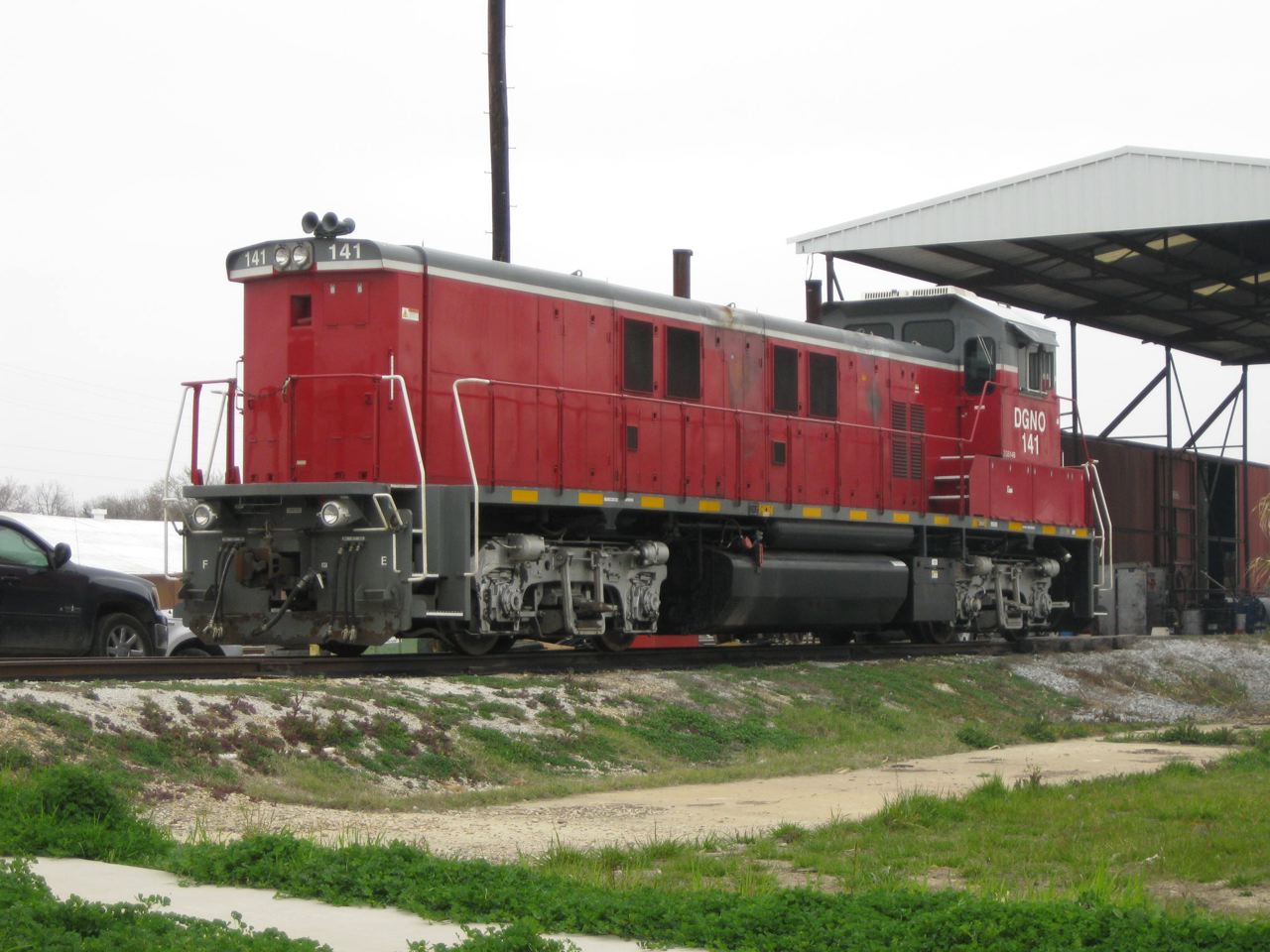 |
| Looking generally south across the DGNO (ex-SSW) track to the Green Line downtown Carrollton station. |
 |
| Up-close and personal. Chuck Weinstock shot the historic plaque; I had missed it. |
 |
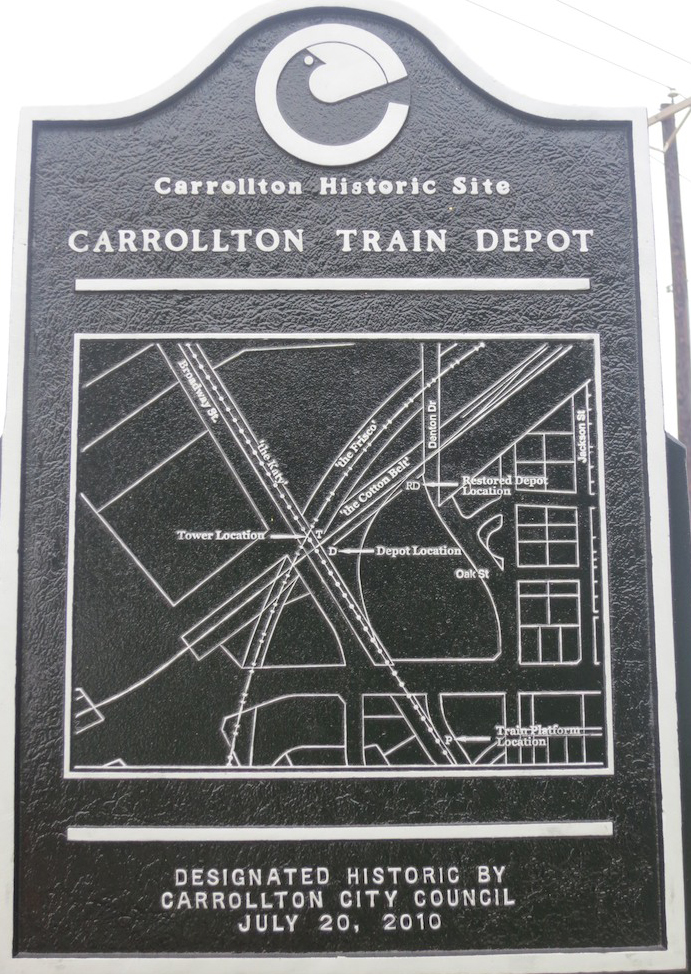 |
| As we were preparing to leave, we heard a horn to the northeast, and here came a southbound Tulsa-DFW BNSF freight, units 4400/4343 and 35 cars, at 9:50 a.m. What luck! |
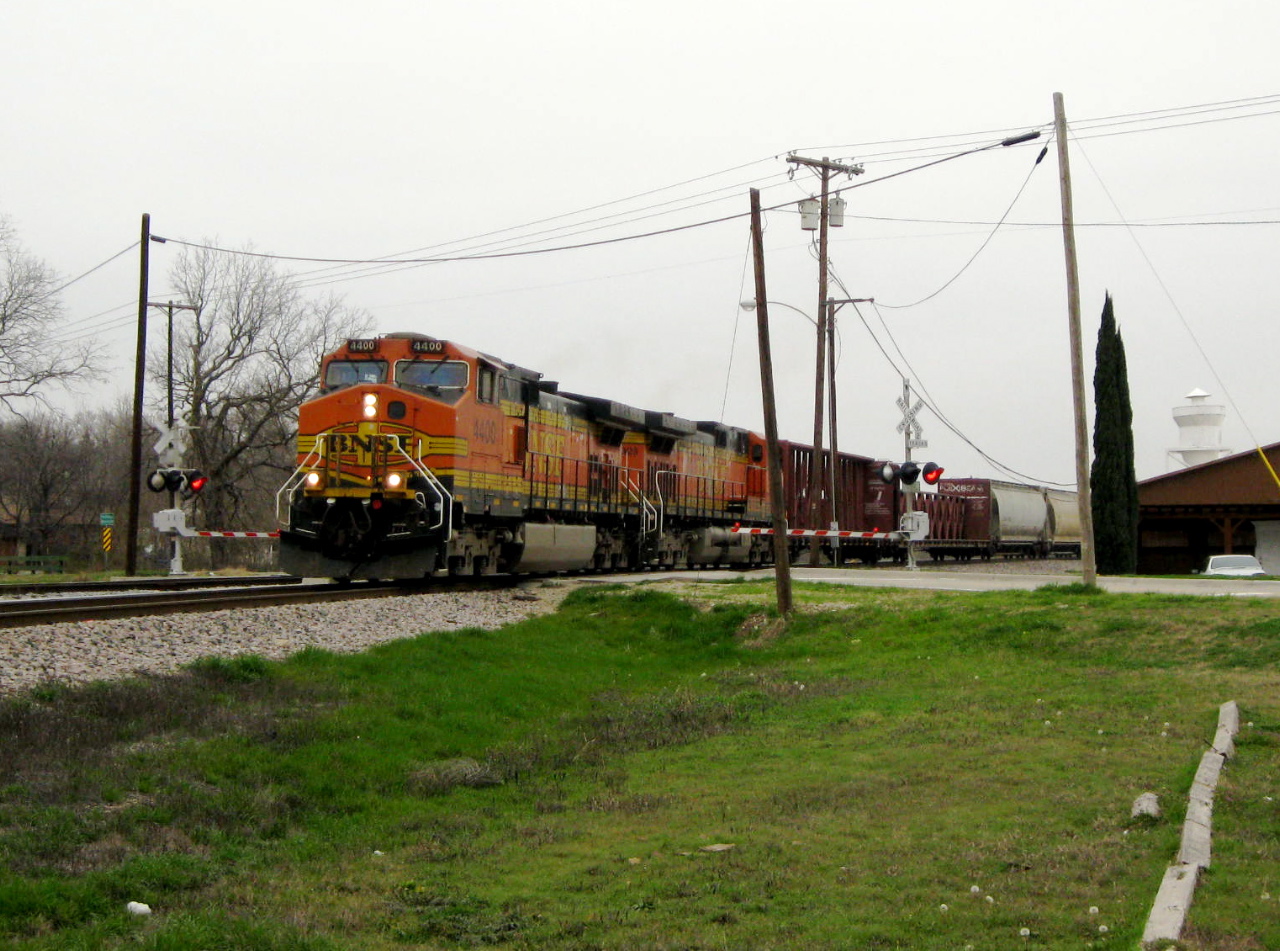 |
| The hoppers beyond the diamond are on side tracks of the DGNO. |
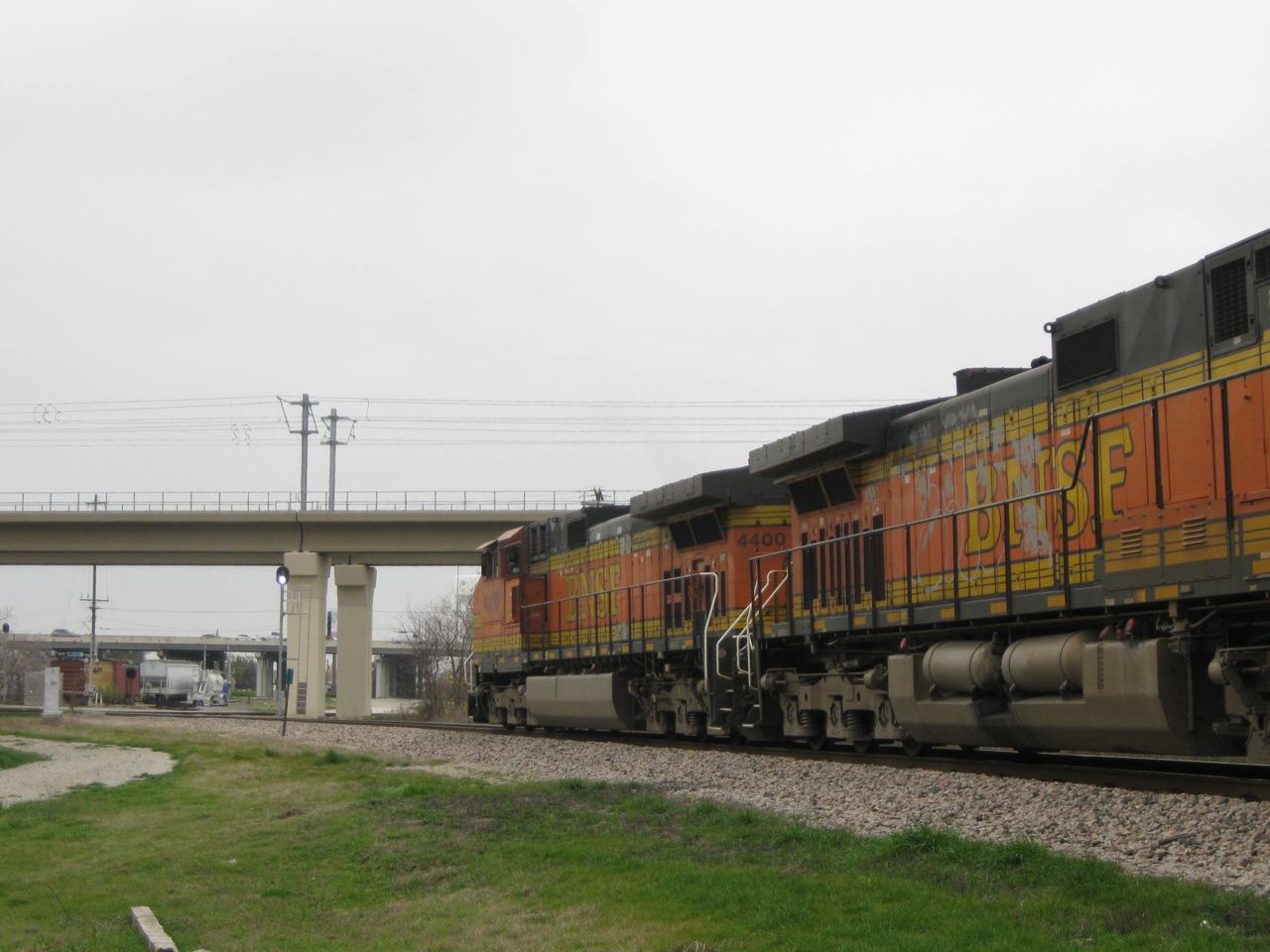 |
| Sure enough, as the BNSF guy proceeded south toward Irving, a southbound Green Line train slid into the station stop above. |
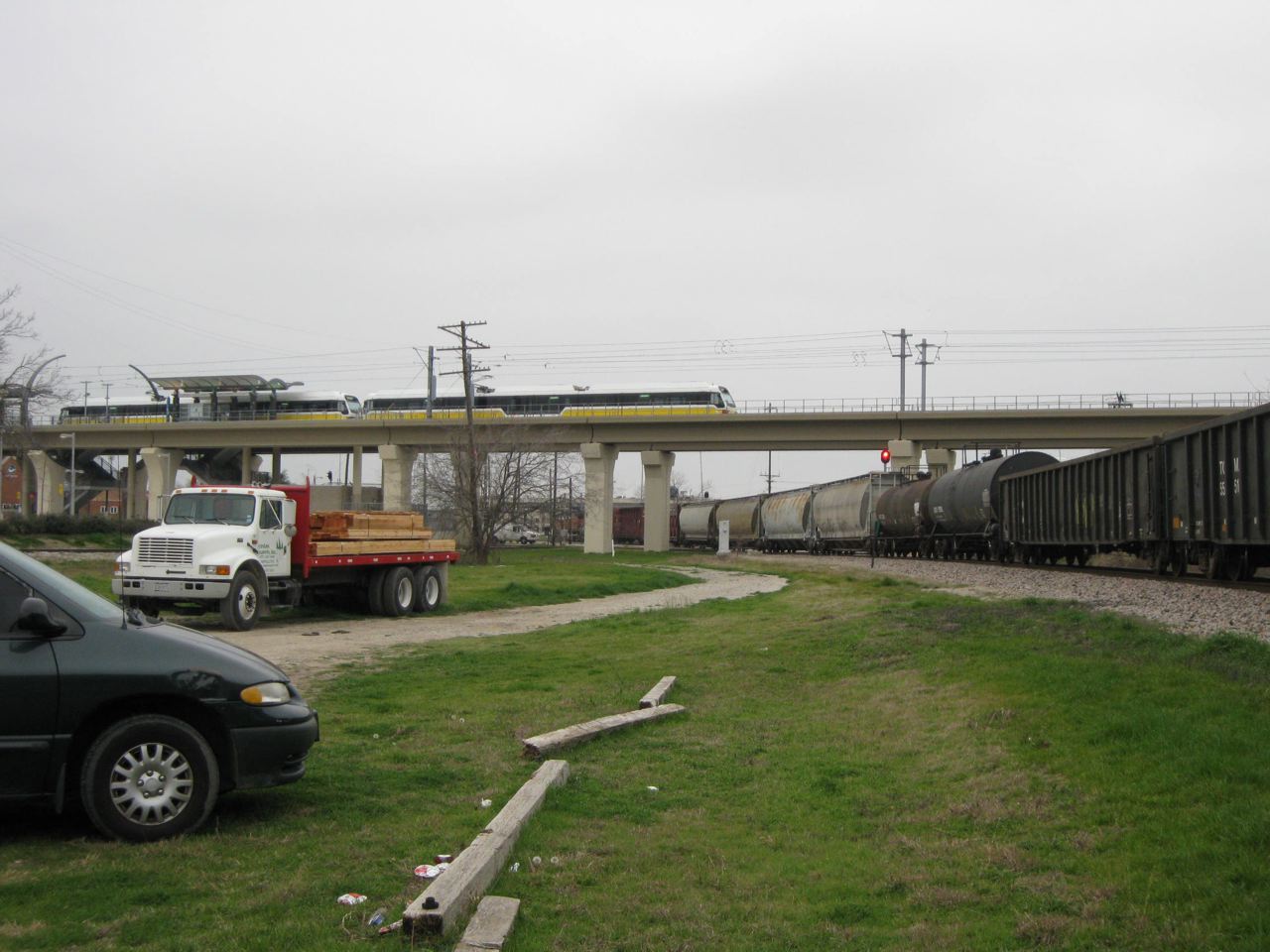 |
| Before departing, I took this shot from the car looking east on the DGNO, with the old Katy branch diamond in the foreground. The two BNSF diamonds are to my left (MKT) and behind me (DGNO). |
 |
| We returned to Dallas downtown and turned in the rental car and waited at Union Station for the Texas Eagle to arrive, reported on-time. There was time for digital views (I took slides on earlier visits) of the passenger train emblems on the platform fencing, a nice touch. |
 |
 |
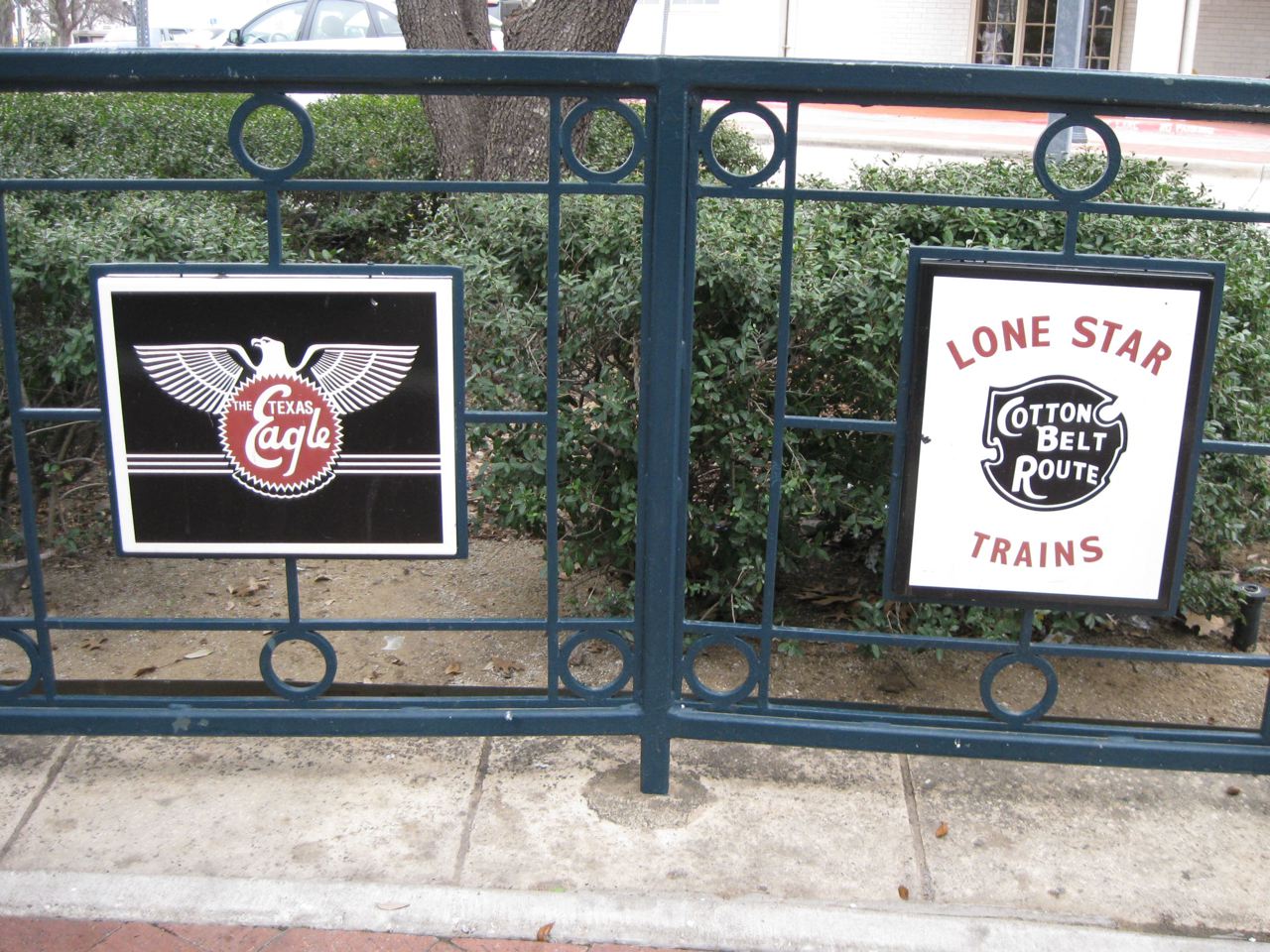 |
 |
| Inside waiting with the luggage on the cool windy morning, I spotted this old shoeshine stand, surely something historic and rarely if ever seen now. (Who wears shoes on trains that need to be shined anymore?) |  |
| The Eagle arrived early with no announcement, so out we went. Our roomettes to Austin (and San Antonio for Otto) were in the dorm car up front, so we walked directly there, and this DART light-rail train came in. He's passing over the viaduct at Dealy Plaza, with the corner of the old Schoolbook Depository just visible, I think, at far right. The Sixth Floor Museum there, regarding the JFK assassination, is well worth visiting, which our family did in 1998. |
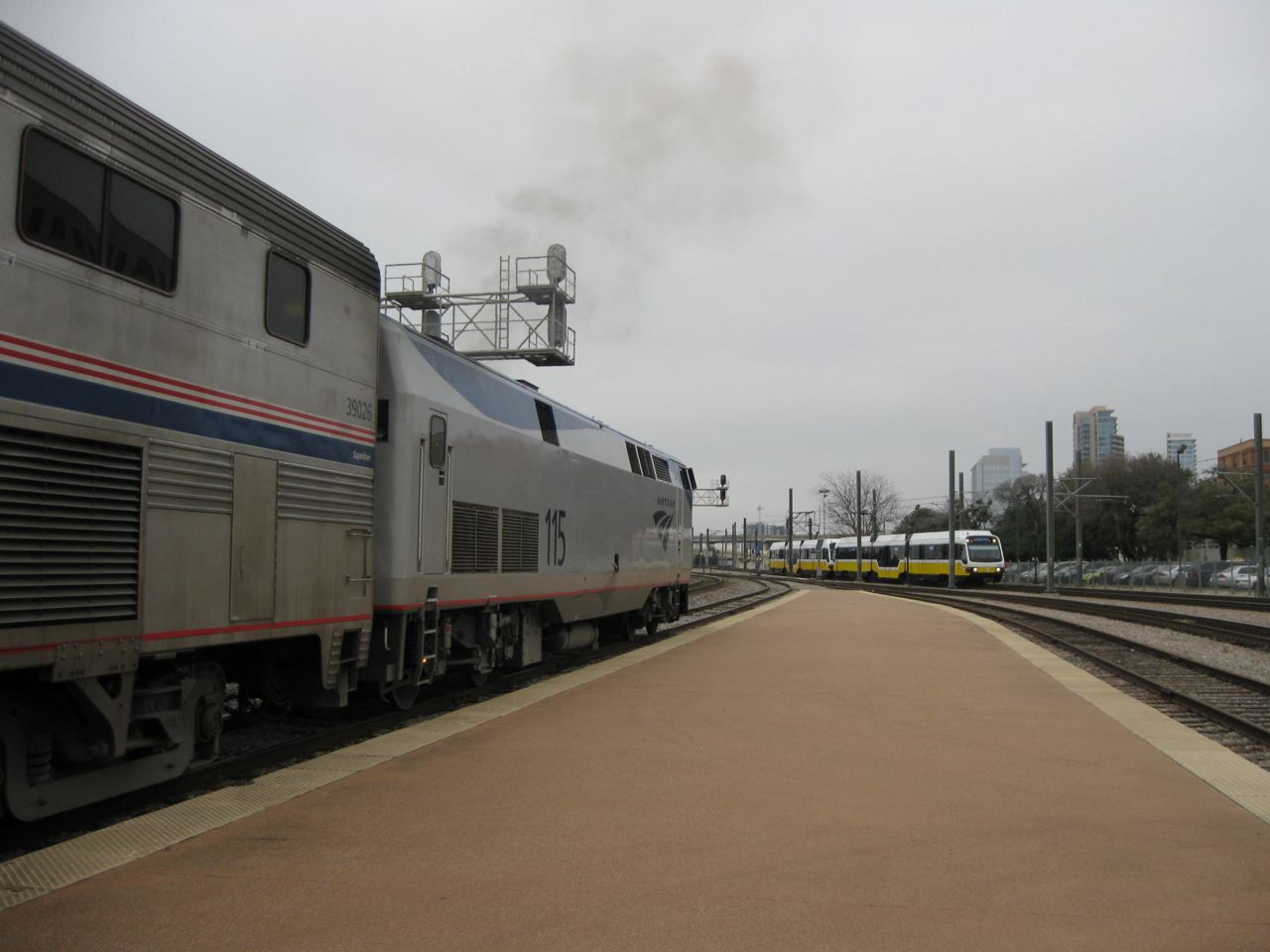 |
| Official pre-departure portrait of #21. A waiter resting in the dorm car opened up the door for us, and soon the condcutor came thru to collect tickets; the dorm has no sleeping-car attendant now, with the regular sleeper on the rear, even tho some roomettes in the dorm are sold to the public. |
 |
| Portrait of track side of Dallas Union Station, thru my roomette window, before our on-time 11:50 a.m. departure. |
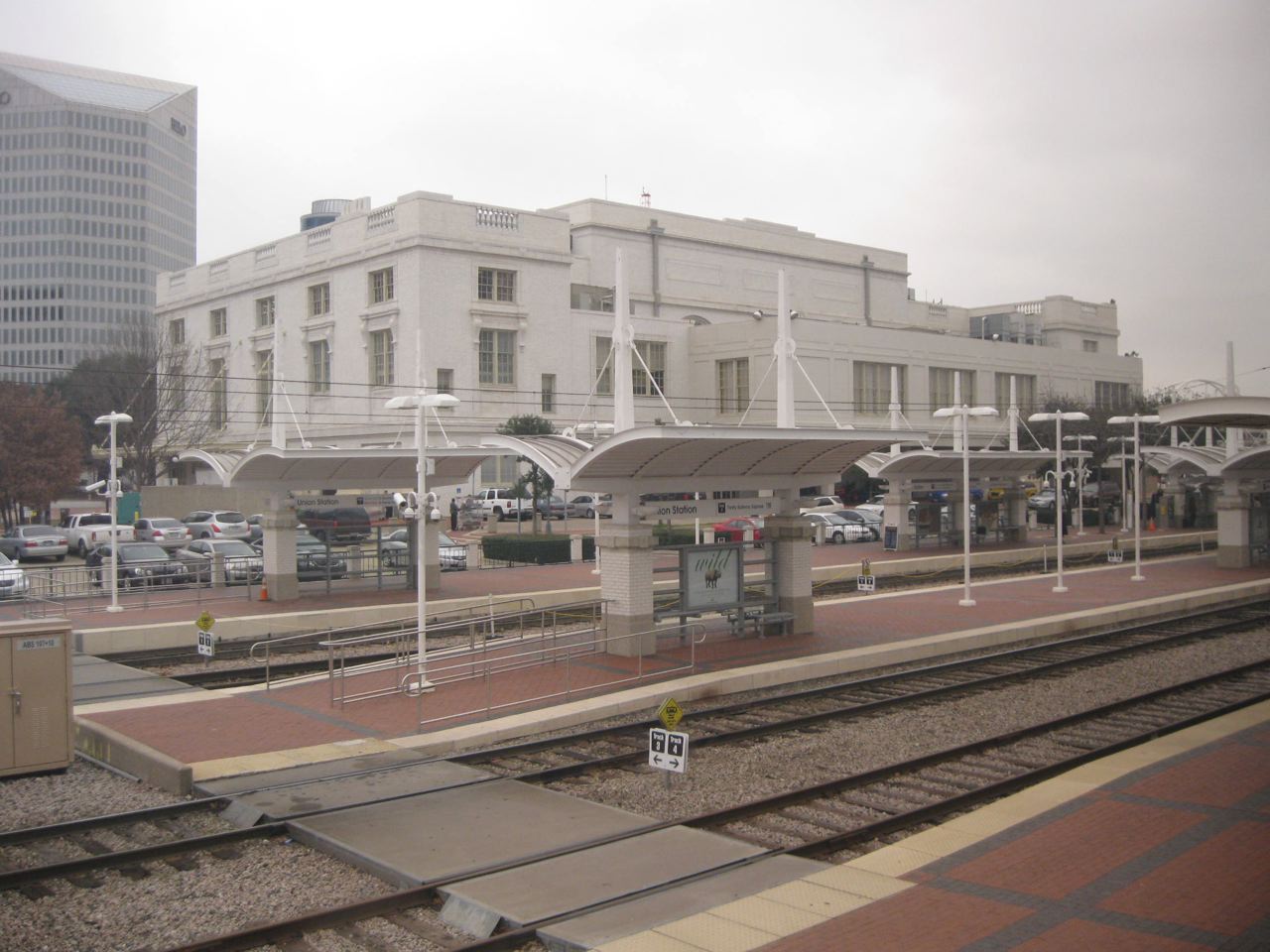 |
| Same view with two DART light-rails in at their platforms. The tracks in between us and DART are for the TRE commuter trains. |
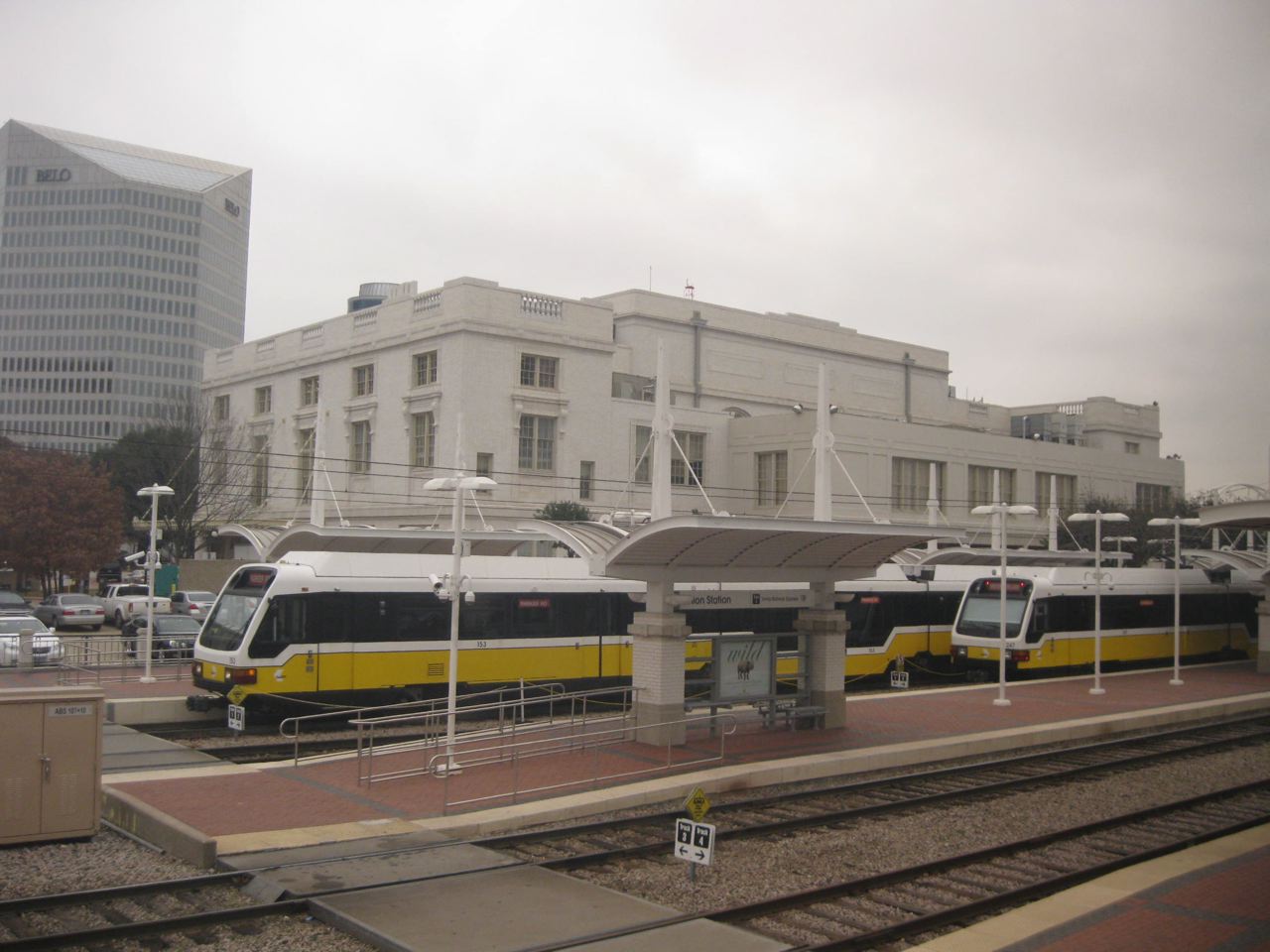 |
| After lunch, we eased -- after some usual UP freight delays -- around the wye at Tower 55 in Fort Worth, prior to backing into Amtrak's Fort Worth station. Time is 12:59. We halted east of the tower at 12:39, moved to the south of it at 12:58, and waited down there until 1:10 before backing into the depot, officially arriving at 1:17. No one who rides Amtrak long-distance trains should be in a hurry! A northbound BNSF merchandise train is passing thru in this photo. |
 |
 |
| Once in the depot, we spent over an hour there. Engine 75 has shoved the Heartland Flyer consist onto its usual parking spur, and is preparing to remove the last car, coach 34109, to be placed -- we guessed -- onto #22, the northbound Texas Eagle, on whose arrival we had to wait before moving on south. The Heartland Flyer has 3 Superliners with a P42 at each end. Amtrak keeps a spare P42 and coach at Fort Worth; they were parked to the east of the depot (behind me and to the right in this photo). |
 |
| Our locomotive is fueled. The Heartland "switcher" and 1 Superliner will come thru this crossover after the fueling, and temporarily block our exit until maneuvering over to the other track behind #22. |
 |
| Here is a Chuck Weinstock photo of the Heartland Flyer, minus the rear unit and 1 car, after the fueling operation on our unit. |
 |
| At or after Fort Worth, here is Chuck working on one of his trip reports, which he sent out each day. |
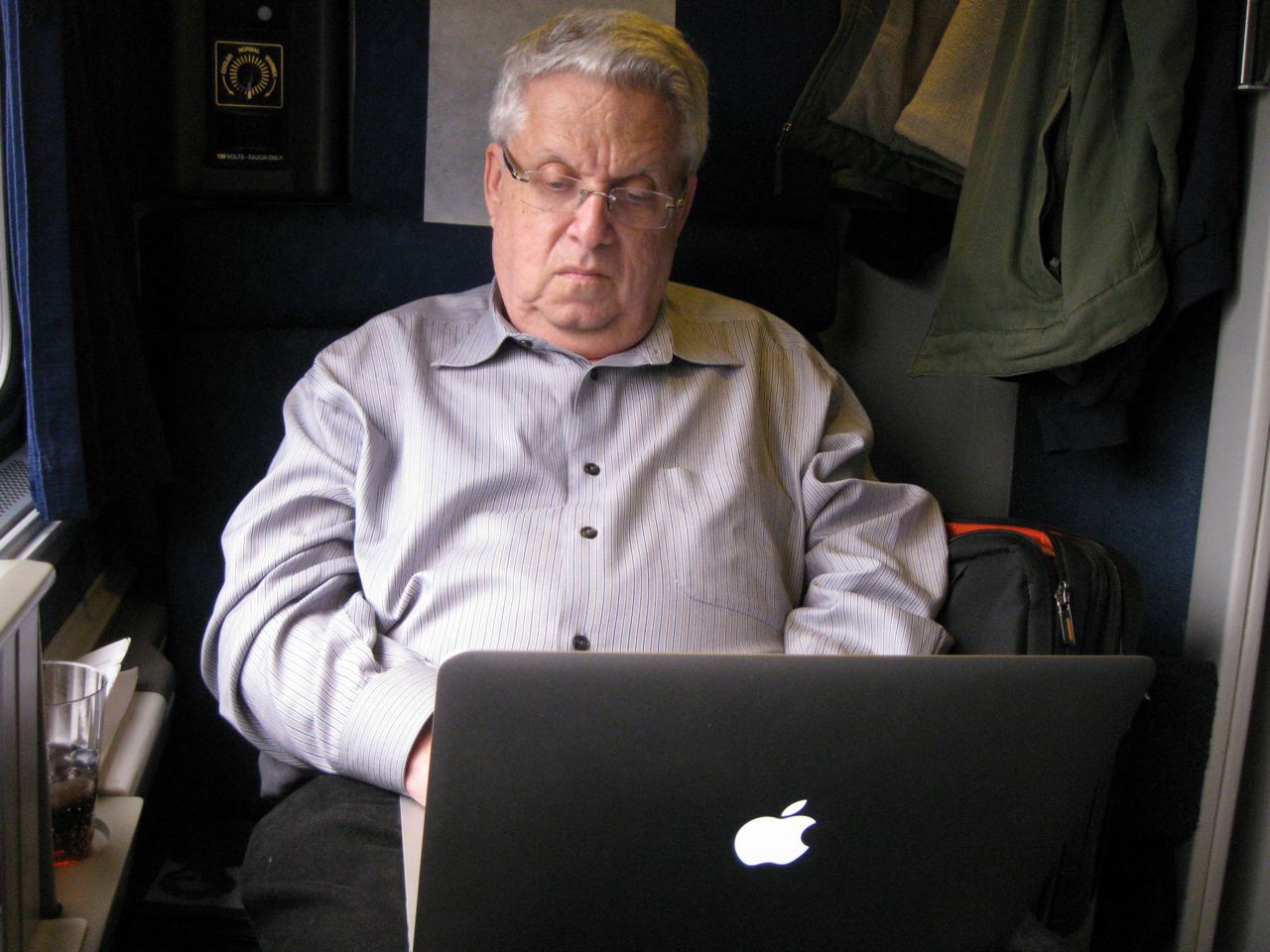 |
| The old ATSF depot at McGregor still serves Amtrak; this is the stop for Waco, due east about 20 miles. A Cotton Belt branch used to cross north of the depot, which was at the diamond. This photo looks northwest. Time is 4:24 p.m. |
 |
| The BNSF yard at Temple had a lot of units, but we were on the shady side, of course. Here is a renumbered SD40-2 and GP38 2049, one of the ex-EMDX leaser units BNSF bought and renumbered in the 2000's but without any repainting. |
 |
| Another SD40-2 with a former Santa Fe GP50X (I think) at Temple. |
 |
| A rail museum collection obscures clear photos of the fine old Santa Fe Temple depot. |
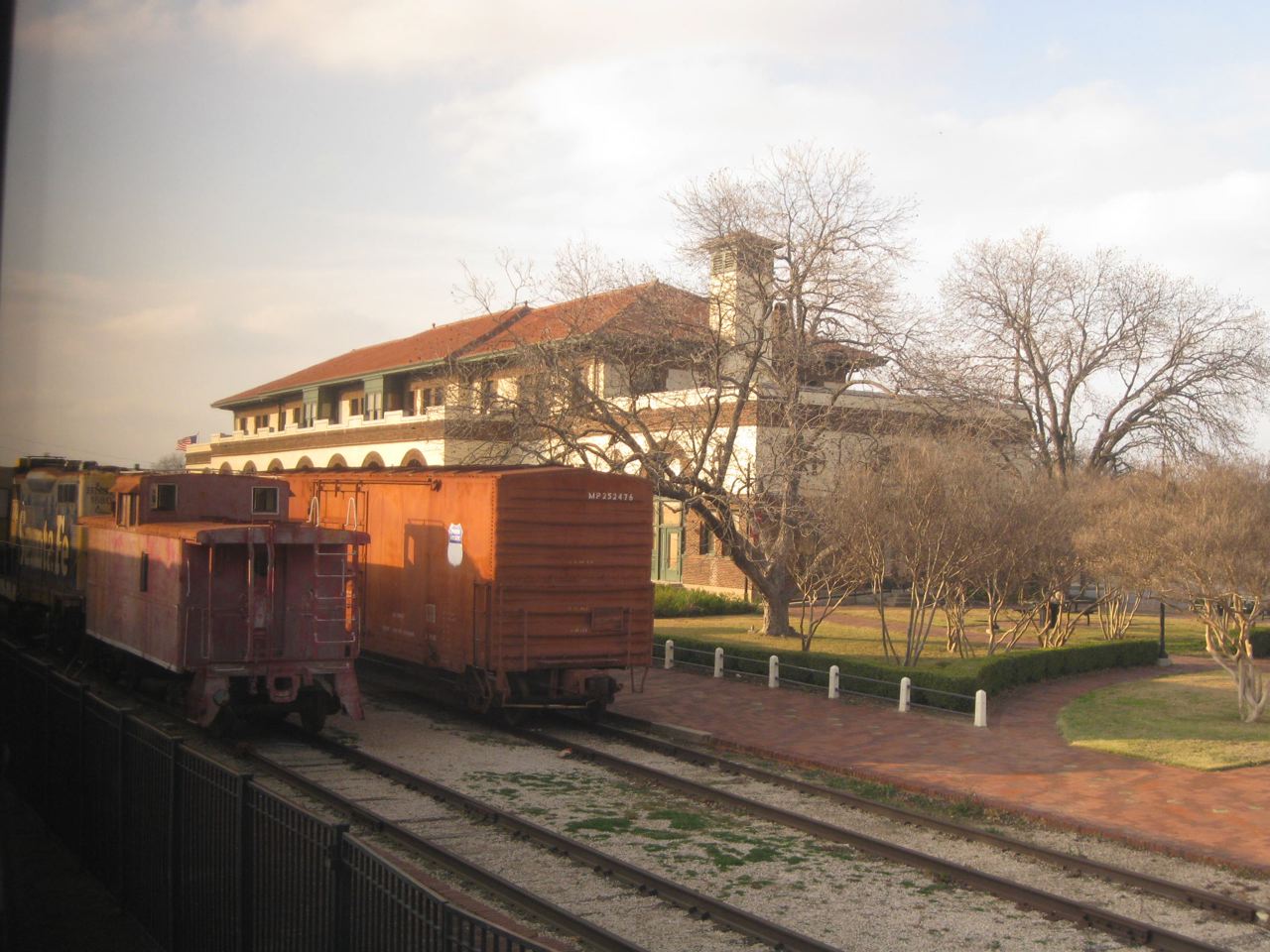 |
| During the stop -- we were running about 10 minutes late, at 4:55 -- there was time to walk back and find a clear window to shoot the Santa Fe High Hood Alco on display at Temple. Note the spread out letters spelling Temple on the building. |
 |
| At cocktail time in the Texas Hill Country, the sun came out. Otto was going on to San Antonio to spend the night, and then come back to Austin, where Chuck and Dave would disembark, next morning. This gained Otto the entire Texas Eagle route on his mileage map. |
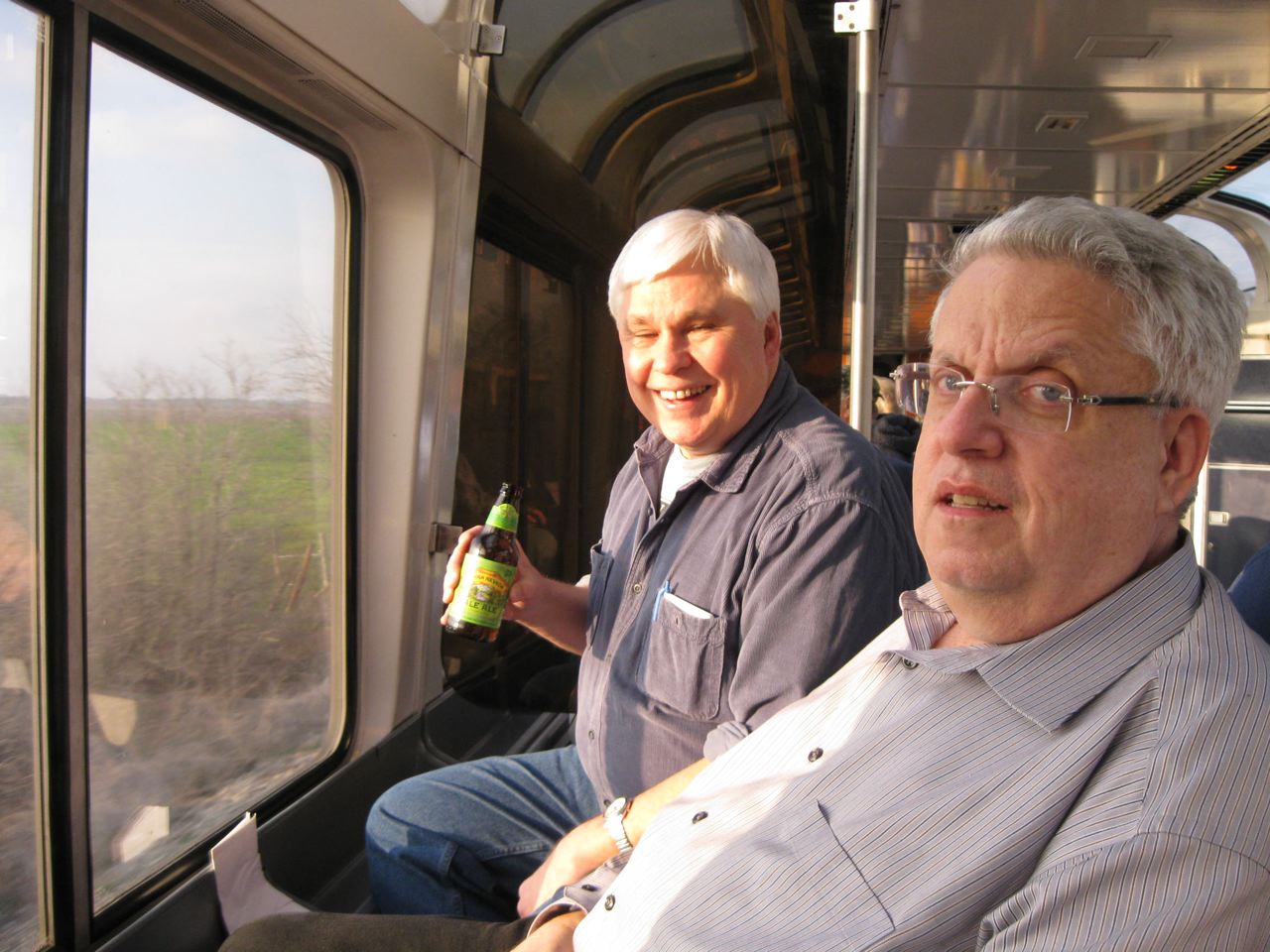 |
| Proof that the photographer was there, too; photo by Mr. Dobnick. |
 |
| We arrived in Austin at 6:28 p.m. basically on-time. Otto was still in the diner. Chuck and I taxied to the motel, and when it turned out there were no restauarants close without walking across six-lane I-35 plus 2 access roads, we treated ourselves to a delicious delivered pizza. |
 |
| On Thursday morning, Feb. 9, Chuck and I taxied to downtown Austin to pick up our one-way rental car to San Antonio, since we didn't trust the Texas Eagle's performance history enough to rely on it to get us to Austin in time to catch the eastbound Sunset Limited, which leaves at almost midnight. Naturally the Eagle was doing well and was well into San Antone in time, but we had other fish to fry. After getting the car, we cruised thru downtown Austin, and I was able to re-shoot both one of the 18 surviving 1890's "Moonlight" towers that lit the city in a pioneering way, and the state capitol nearby. I got good slides of both on our 1998 Texas family vacation. |
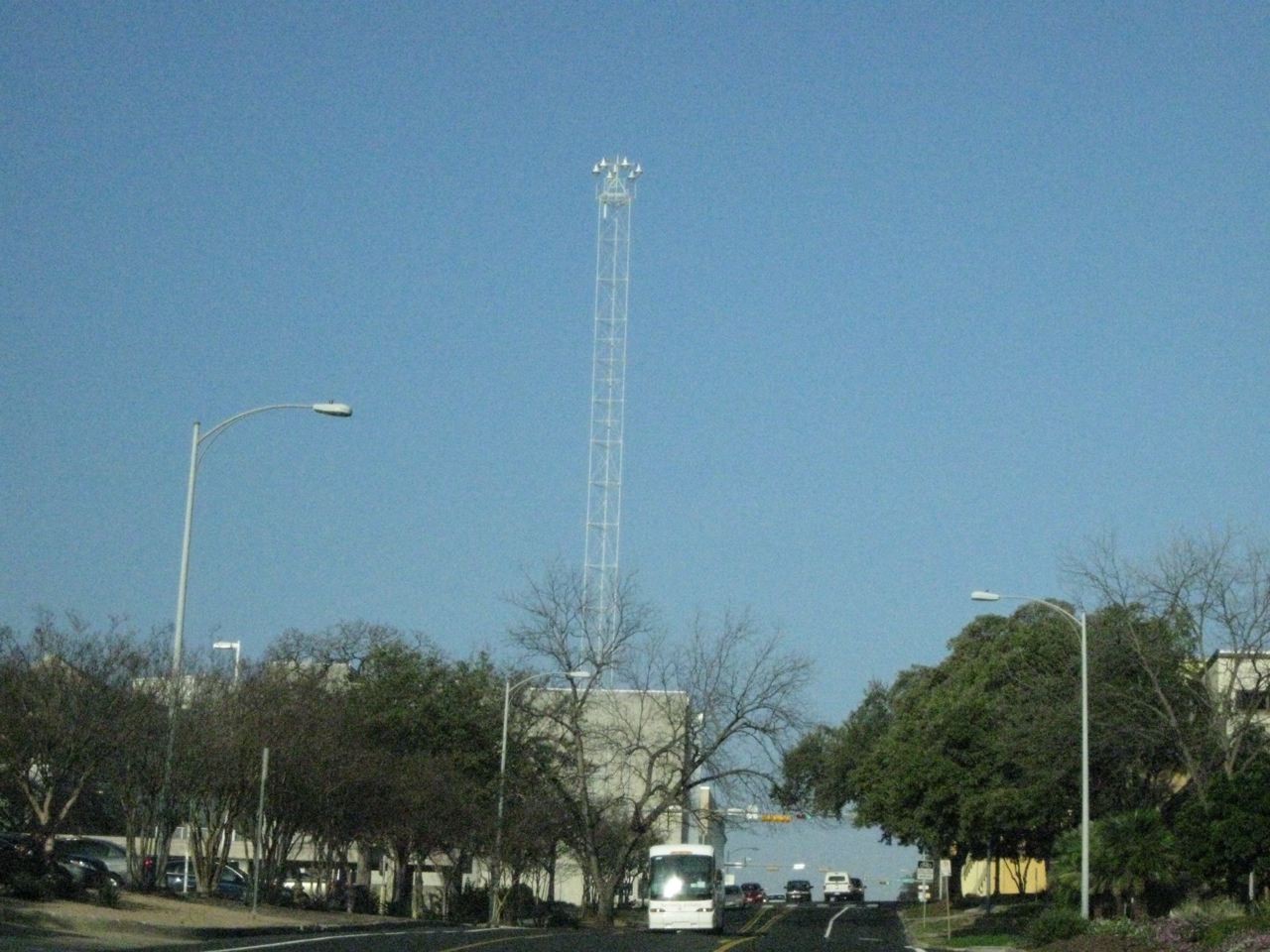 |
 |
| Otto was due into Austin from San Antonio on the Eagle around 9:30 and got in a little early. |
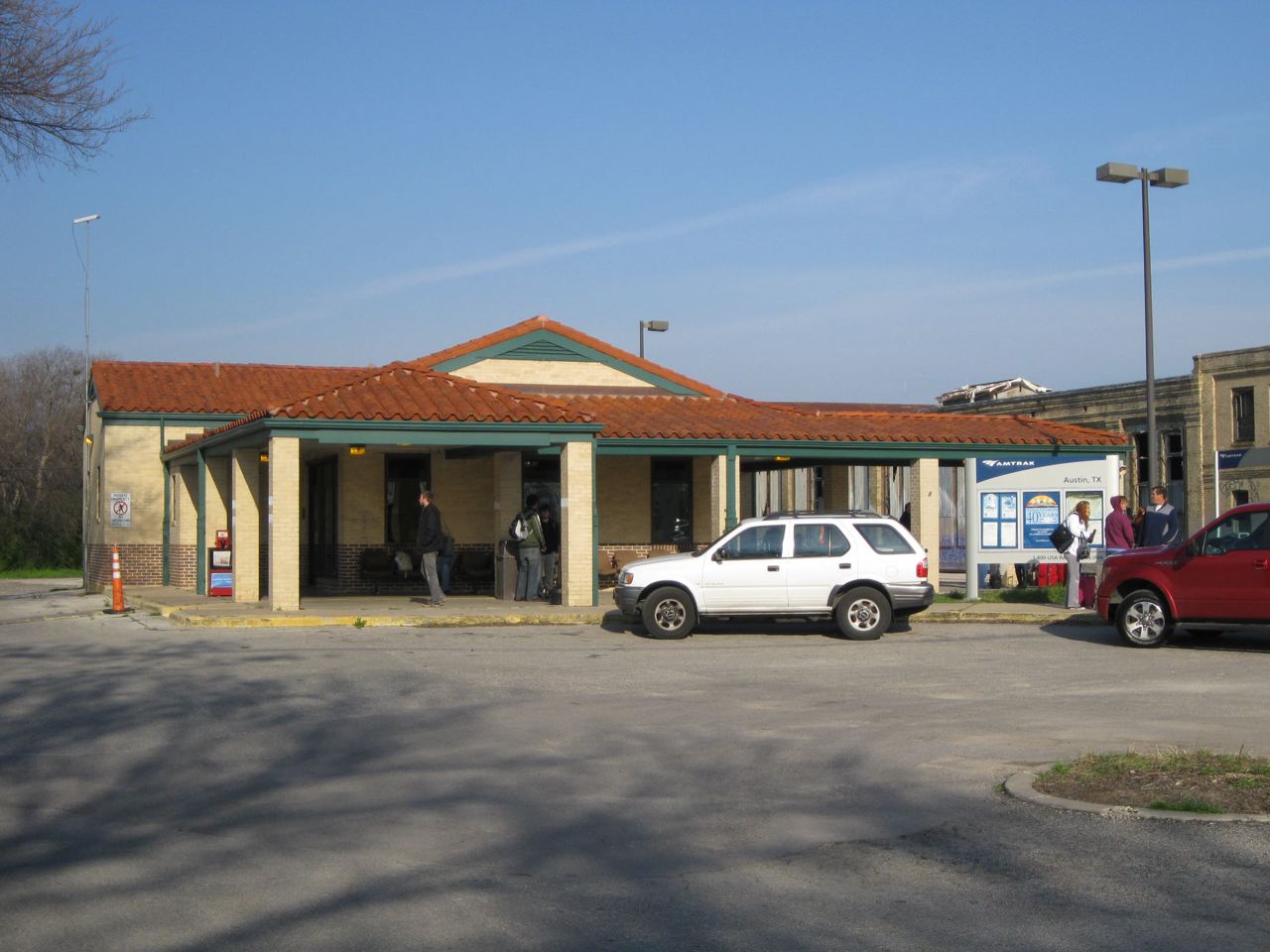 |
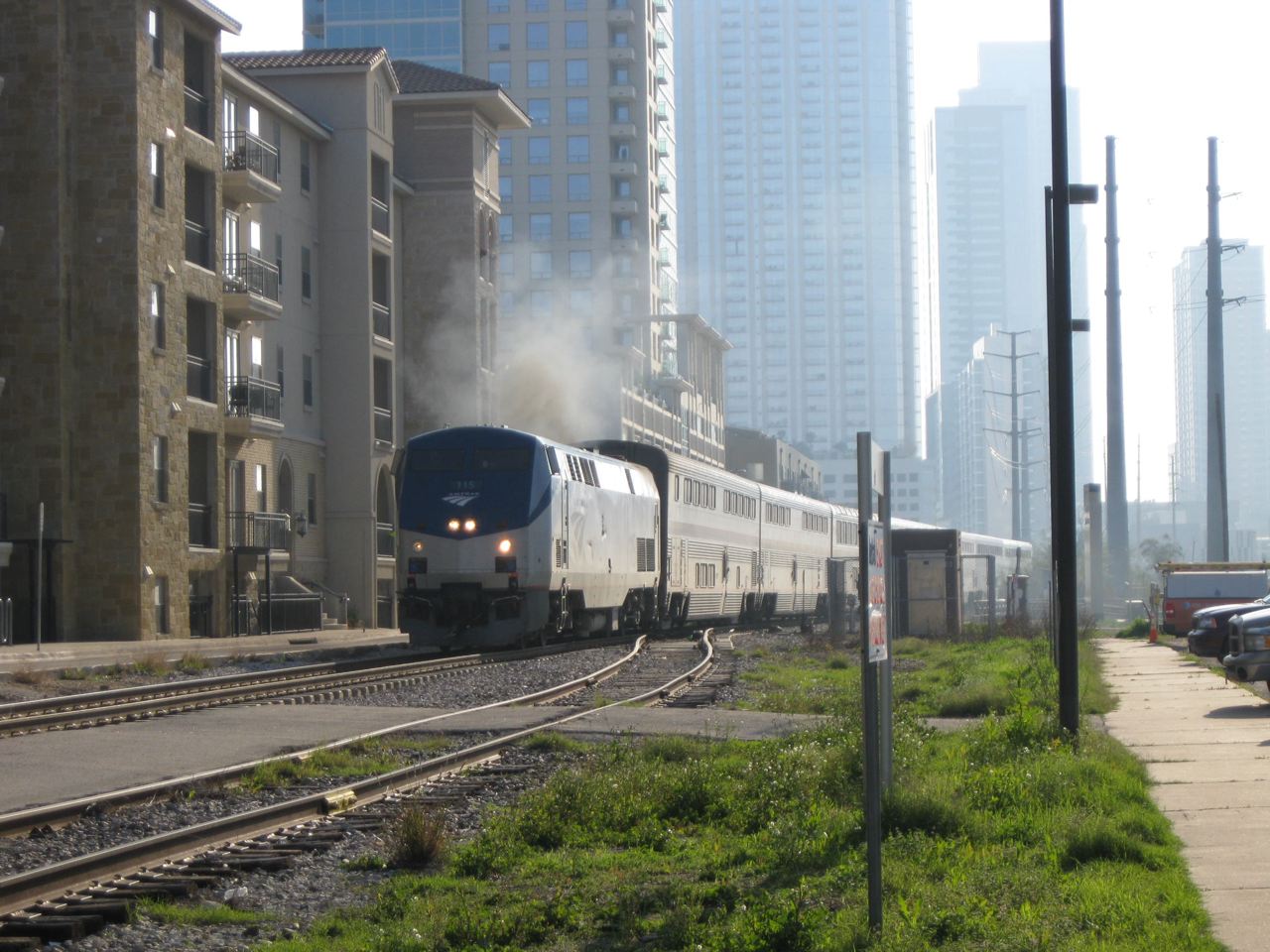 |
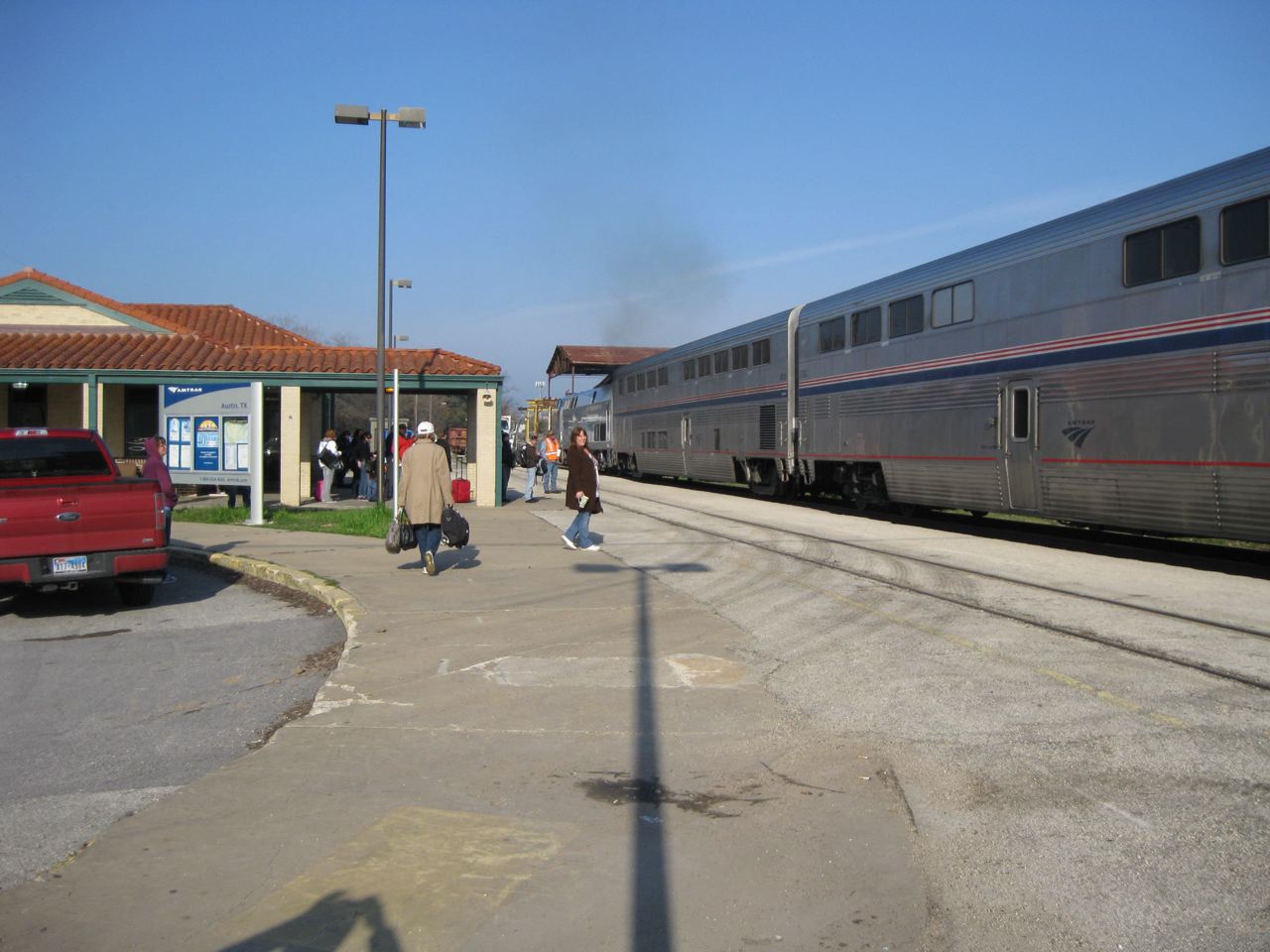 |
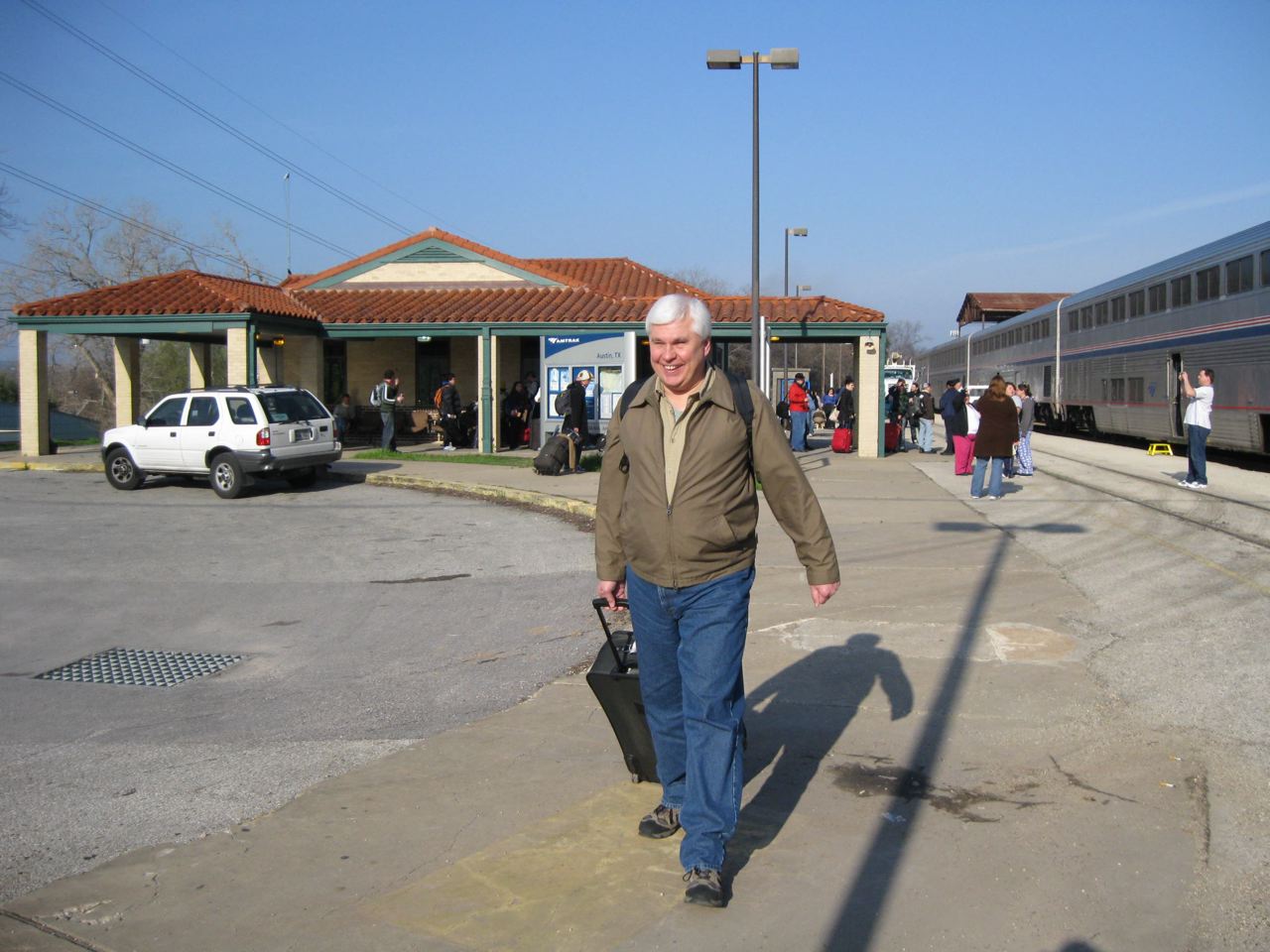 |
| We basically had nothing to do until mid-afternoon, since after the morning rush hour, one cannot ride the commuter line's entire route between downtown Austin and Leander until then. So, we scouted the line, looking for a likely spot to park the car and do the line by first going into downtown, then out to Leander on the first train to go all the way out there, then return--on the only train to flip back from Leander in the afternoon--to our parked car and head for San Antonio. The service, DMU's going under the banner Capital MetroRail, uses 32 miles of a former Southern Pacific branch, although the track from the wye (with the line out to Elgin and on east) into the downtown "terminal" is not quite on the old SP alignment, and a new flyover was built at suburban McNeil to avoid interference with UP's main line (ex-MoPac, also the Texas Eagle route). Capital Metro is strange -- only 9 stations, and virtually no rider parking at the 6 in-city stops, only at the 3 outer suburban ones. A one-way ride takes about an hour. Service in midday (10-3, roughly) is hourly but ends one stop short of Leander, at Lakeline. The same branch hosts the Austin Steam Train Association's tourist train out to Burnet, Texas, from Cedar Park, and both Otto and I have done that. But Cedar Park opted out of Capital Metro (individual communities may do that in Texas), so there is no commuter stop where the tourist train operates from -- you must go beyond to Leander, and only 5 rush-hour (morning inbound, evening outbound) serve Leander. Moreover, only the one outbound in afternoon flips back, so we had to use that train (same is true in the mornng, only one outbound goes to Leander to flip back). We followed the Metro as far as Howard, a big park and ride lot near a the 1 Loop freeway (aka MoPac Freeway in town, where the UP main is in the median) on the northwest end of Austin, where we bought a ticket from a machine after just missing an inbound train that could've knocked off the city end of the route first for us. No biggie. We'd also missed photographing two trains passing as we scouted the line out from downtown. So, with a deadline of being back at Howard by 2:30, we drove east 30 miles to Elgin, Texas, and a BBQ lunch at the Southside Market, which Chuck had determined was one of 3 or 4 best BBQ joints in the region, by reputation. Lunch was fine, and with plenty of time left, we went on into Elgin proper to look around its preserved depot, at the crossing of the same SP line the Capital Metro uses in Austin, as you continue east, with the UP's ex-Katy main line between DFW and Smithville, where it used to split for Houston or San Antonio. The SPV shows the ex-SP thru Elgin as abandoned, but it exists and had cars on it in the east end of town. The line is, in fact, intact and in service all the way from Giddings on the east, thru Elgin and Austin, out to Llano,with branches to Burnet and Marble Falls, as the Austin Western Railroad, a 155-mile pike that is part of the WATCO system. The ex-Katy thru Elgin looks in good shape as a secondary main route. |
 |
 |
| We look north on the former Katy, toward Waco. | West of the diamond on the ex-SP is this former freight house, now the chamber of commerce. We look east. The Union Station at the crossing is a small railroad museum. |
 |
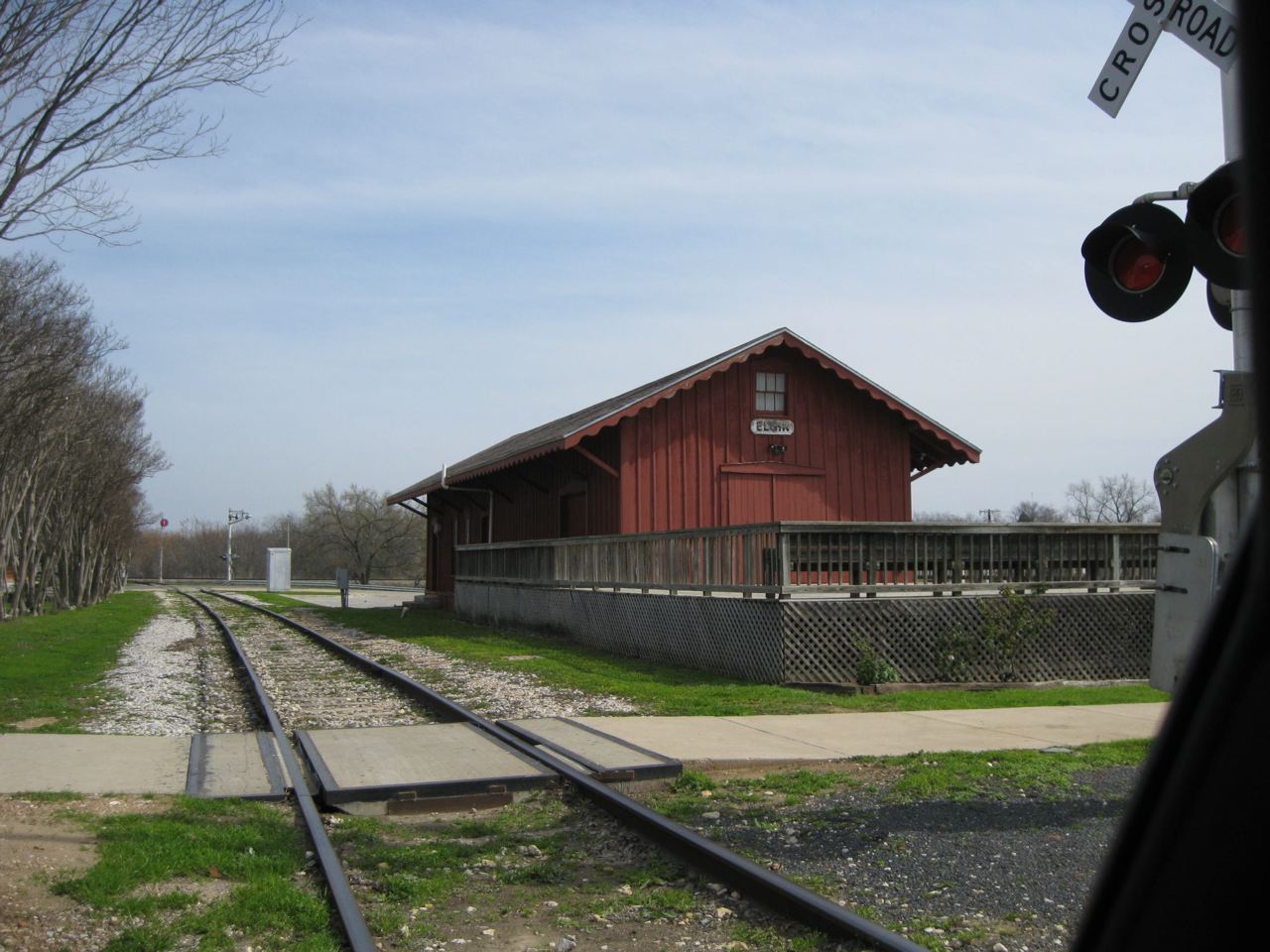 |
| With a little time left before our 2:30 deadline to board Cap Metro at Howard, we went on out a couple of more miles to McNeil to photo a commuter or two on the flyover, and first were treated to this northbound UP freight. My Canon digital mis-fired (think I got a slide), so here is Chuck Weinstock's photo of the 4056/4192 north at 1:39 p.m. The diamond is still there because freights on the Austin Western still ply that ex-SP route, with lucrative aggregates traffic from out west in the Hill Country. |
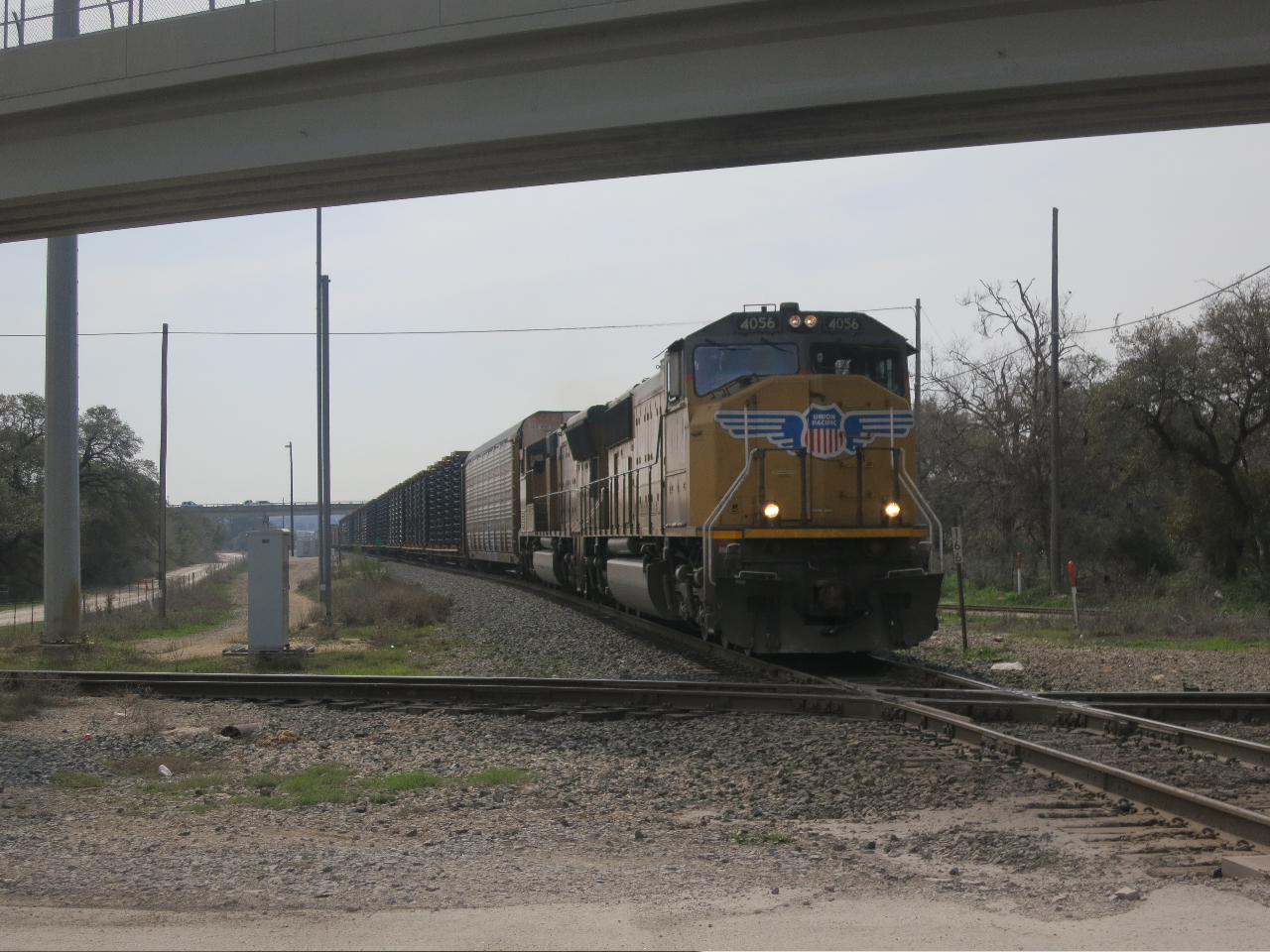 |
| Here are two half-out-of-focus views of the UP freight passing, from my Canon, which sometimes has its lens get a little wiggly. |
 |
 |
| And now it was time to experience our Austin target, the Capital Metro commuter train. |
 |
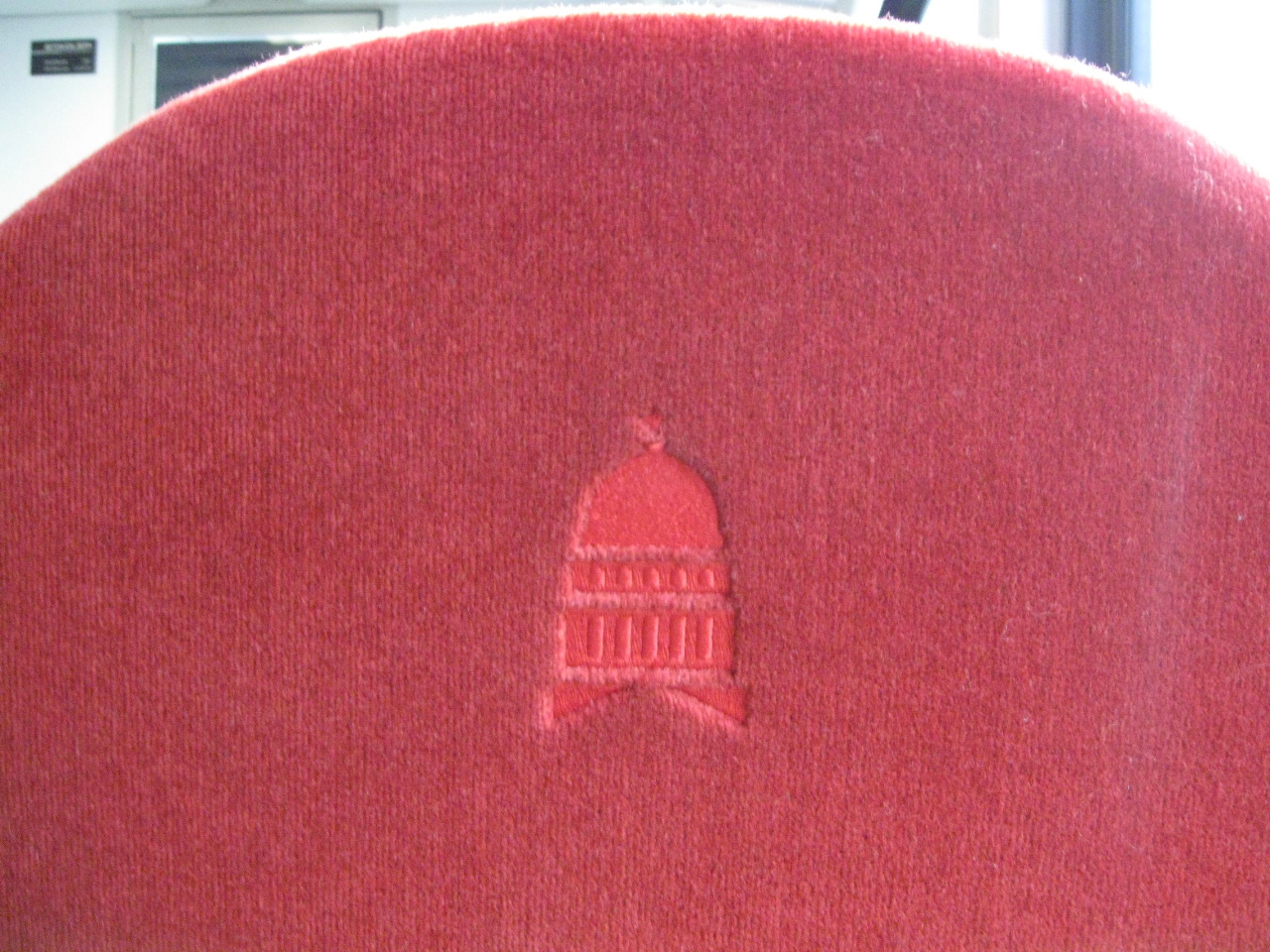 |
| Here comes our first Cap Metro we were able to photograph, on the flyover and bound for Lakeline, at 1:51. The car duo is numbered 104; there appear to be six such sets. The headlight is on one of two UP Geeps in the Austin Western interchange yard, picking up an aggregates train. We did see, but not photo, two AW units near here. The majority of their power was undoubtedly out west on the railroad, since they must run here at night after Cap Metro shuts down. |
 |
| And there goes 104 north, passing what apparently is all there is anymore to McNeil, a general store/post office. |
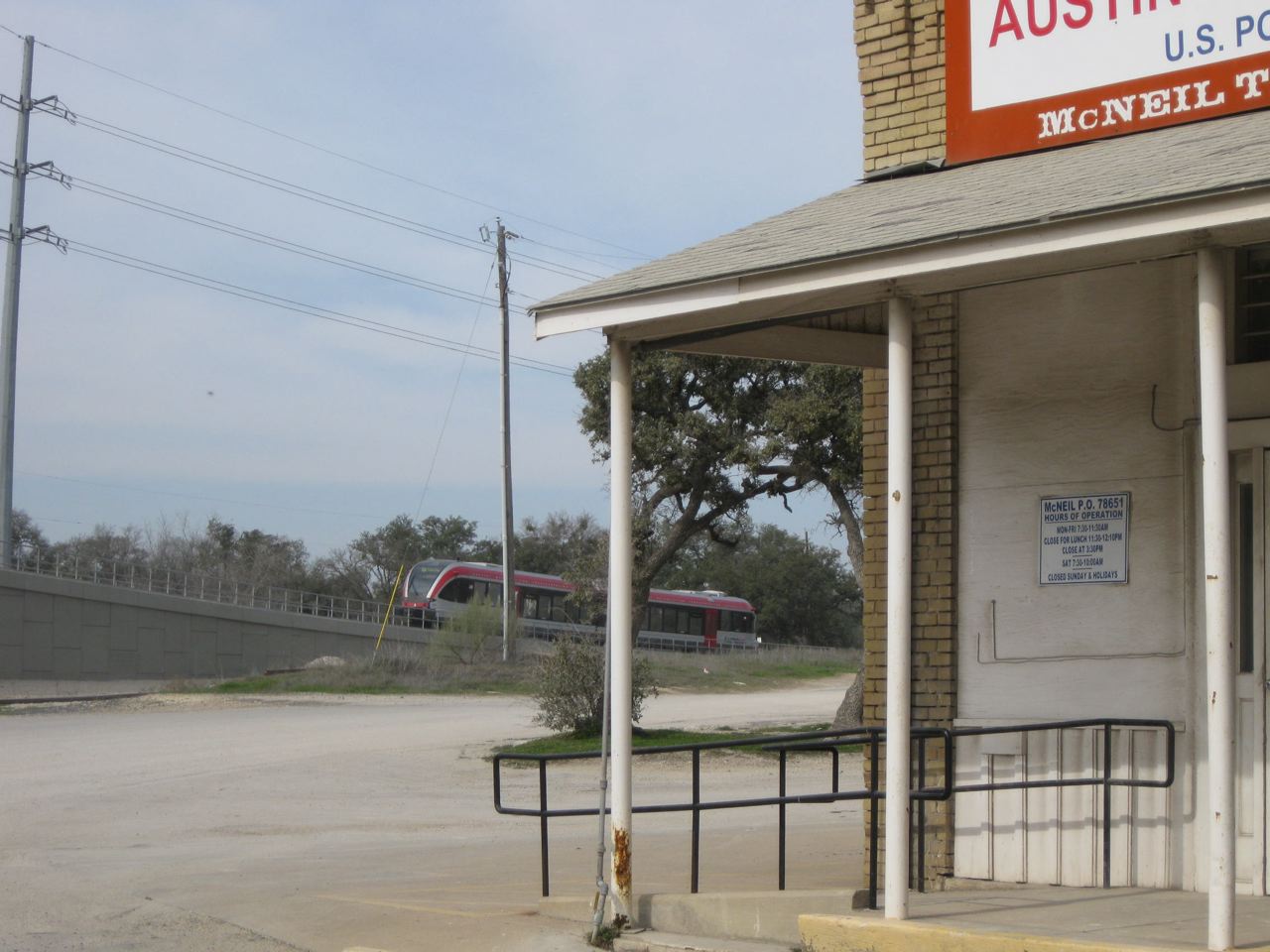 |
| A couple of McNeil tourists pose. One of the area's many huge rock quarries is visible at right, across the UP and to the north. |
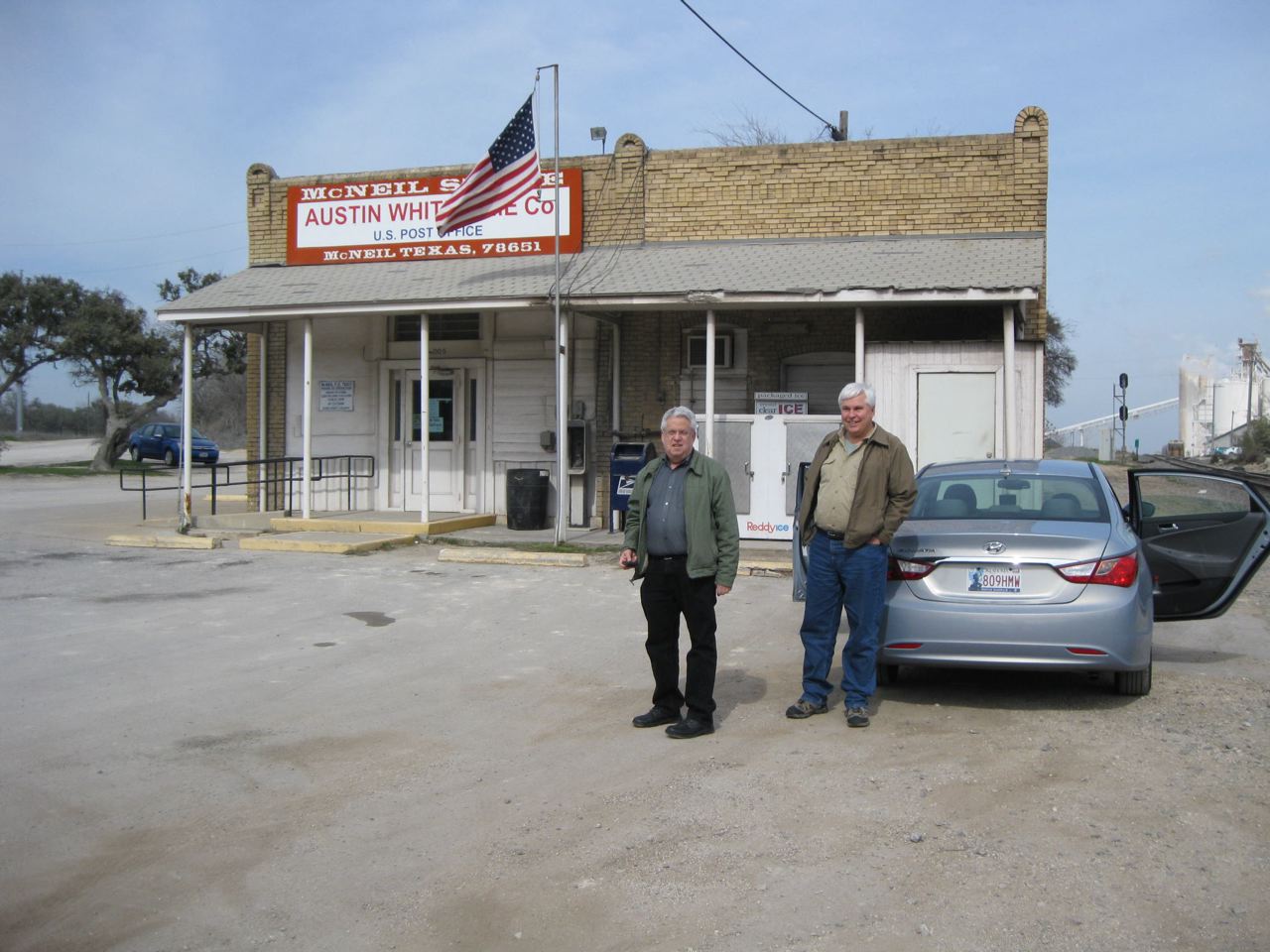 |
| At 2:32 p.m., here comes CapMetro DMU set 106 into the Howard Lane park-and-ride station to pick us up. |
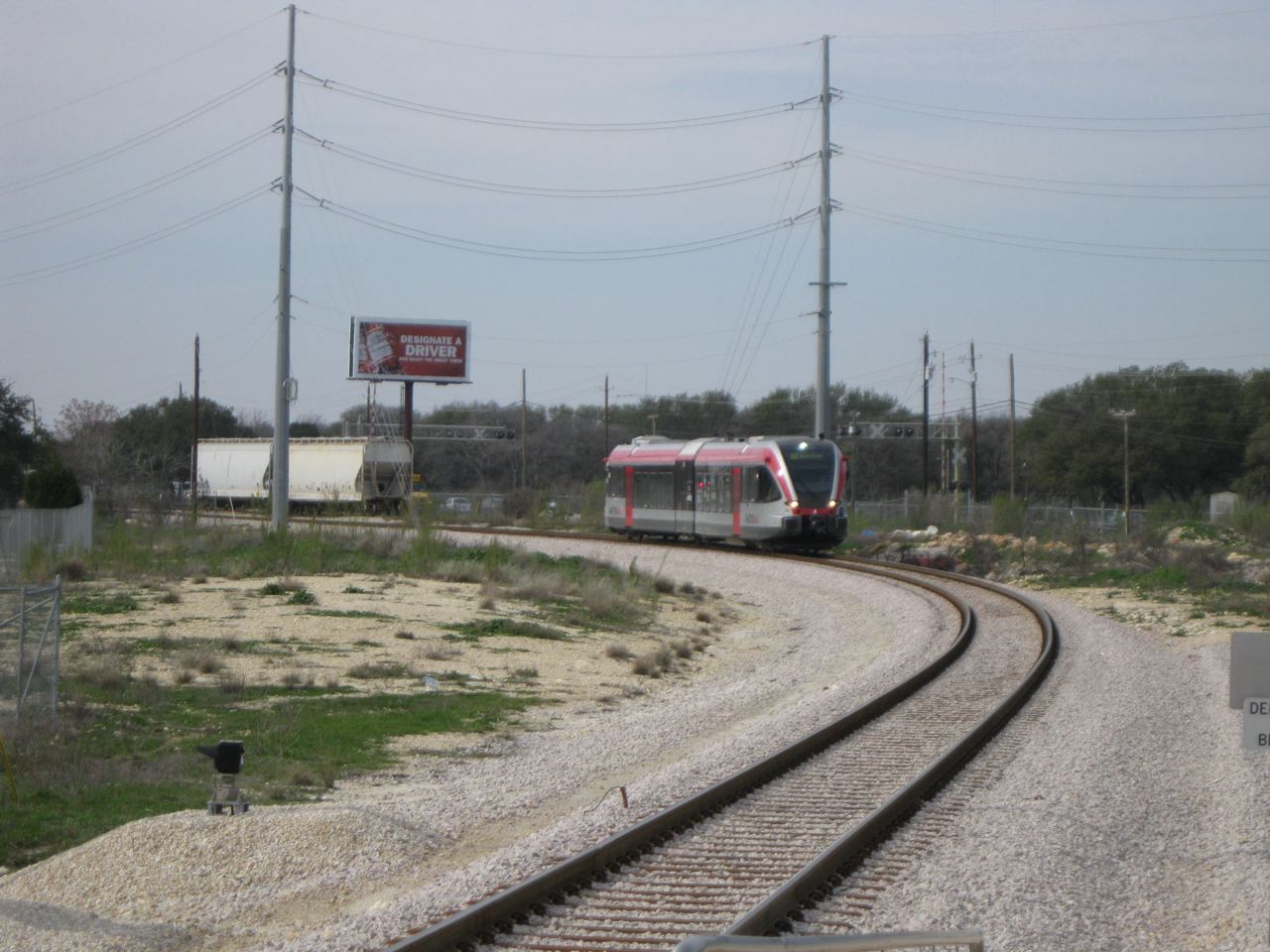 |
| We sat up front in the lead portion of the car. Passengers cannot go between halves of the car. The floor here, at each end, is raised over the trucks. I believe the A-Train's DMU's are similar or identical to these in Austin. | Otto looks out the window while Chuck reads his Kindle. Few people were on this train. |
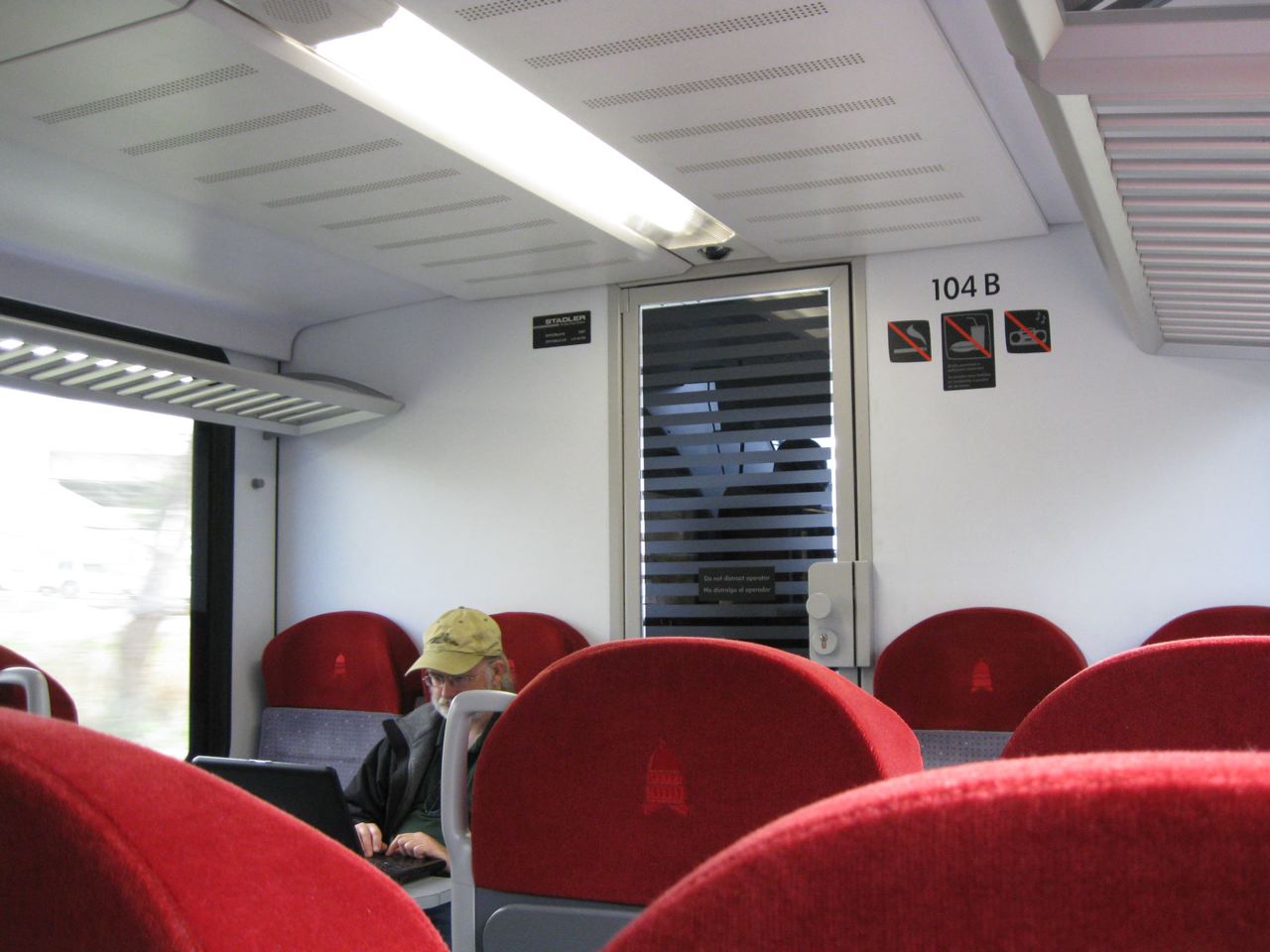 |
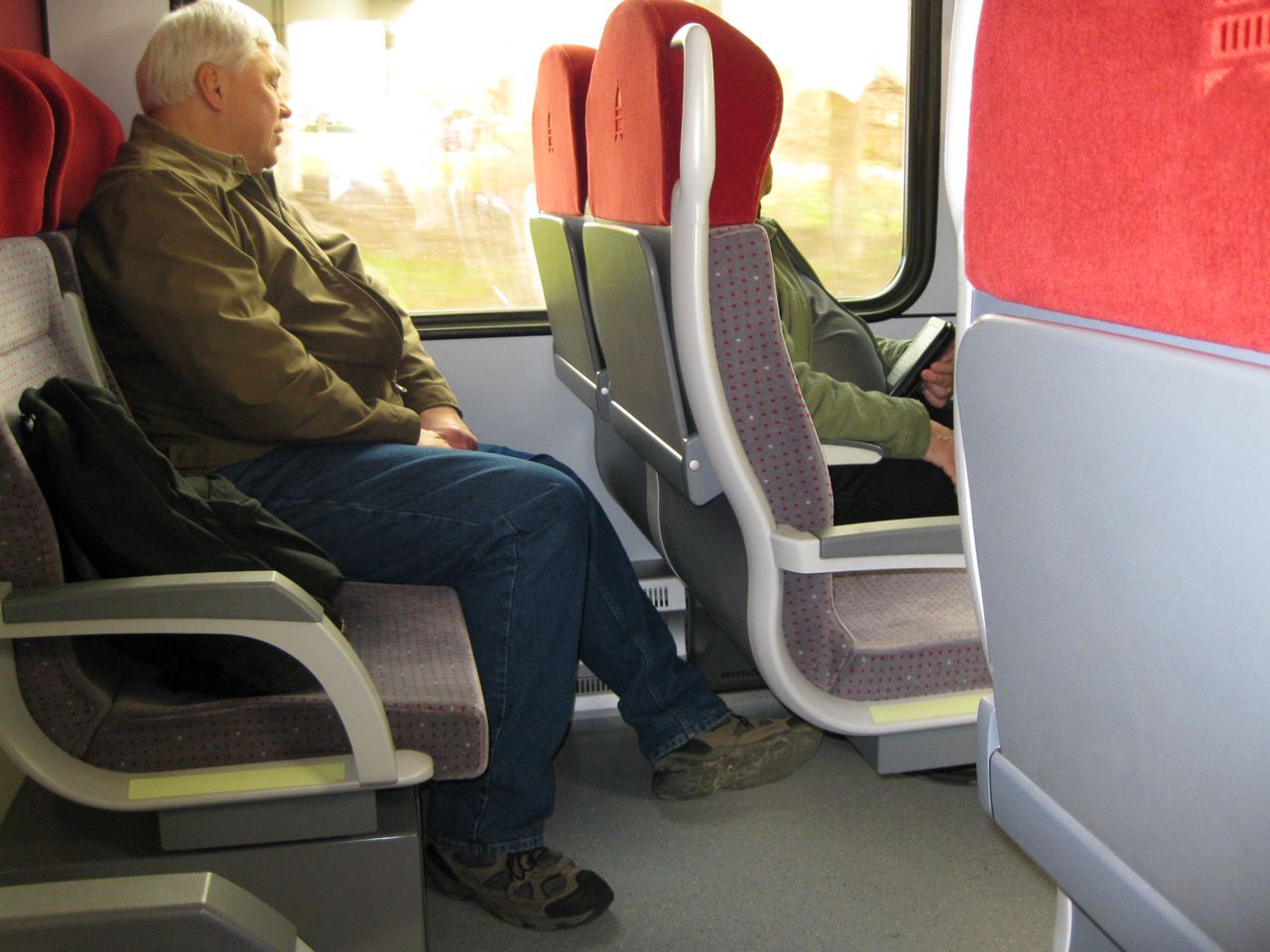 |
| Glimpses of the shops as we passed, between Kramer and Crestview stops, IIRC. |
 |
 |
| End of the line in downtown Austin, at 4th and Trinity Streets, between the downtown Hilton Hotel and the Austin Convention Center. This view looks northwest ("west"). We arrived right after 3 p.m., and had time basically to take the pictures you see, and by the time I reboarded, the train was almost full. We all sat separately outbound to Howard, where half the train emptied. We left at 3:15. |
 |
 |
| The convention center is at left. We were told ridership thus far has never obliged running two sets together in M.U. The startup of CapMetro was delayed well over a year, IIRC. |
 |
| At the wye where we turn from eastbound to northbound, there is an active freight siding that leaves the "main" behind us as we look north here, going around the wye's curve, and crosses ahead of our train at a diamond that is bascially behind the signal bungalow in this view. A modeler's delight! |
 |
| Meets are scheduled at the 3rd in-city stop, MLK Jr. Drive. |
 |
| Our train was going only to Lakeline, so we disembarked at Howard at 3:50 and sat in the car, out of the cool breeze, during our layover. |
 |
 |
| Here comes the first train to Leander, which will become the only one to flip back into the city, into Howard a half hour later, at 4:19. It's trainset 106. |
 |
| Here's the interior of the lead portion of trainset 106, looking toward the motorman's compartment. A few window seats were available out of Howard, but not many. |
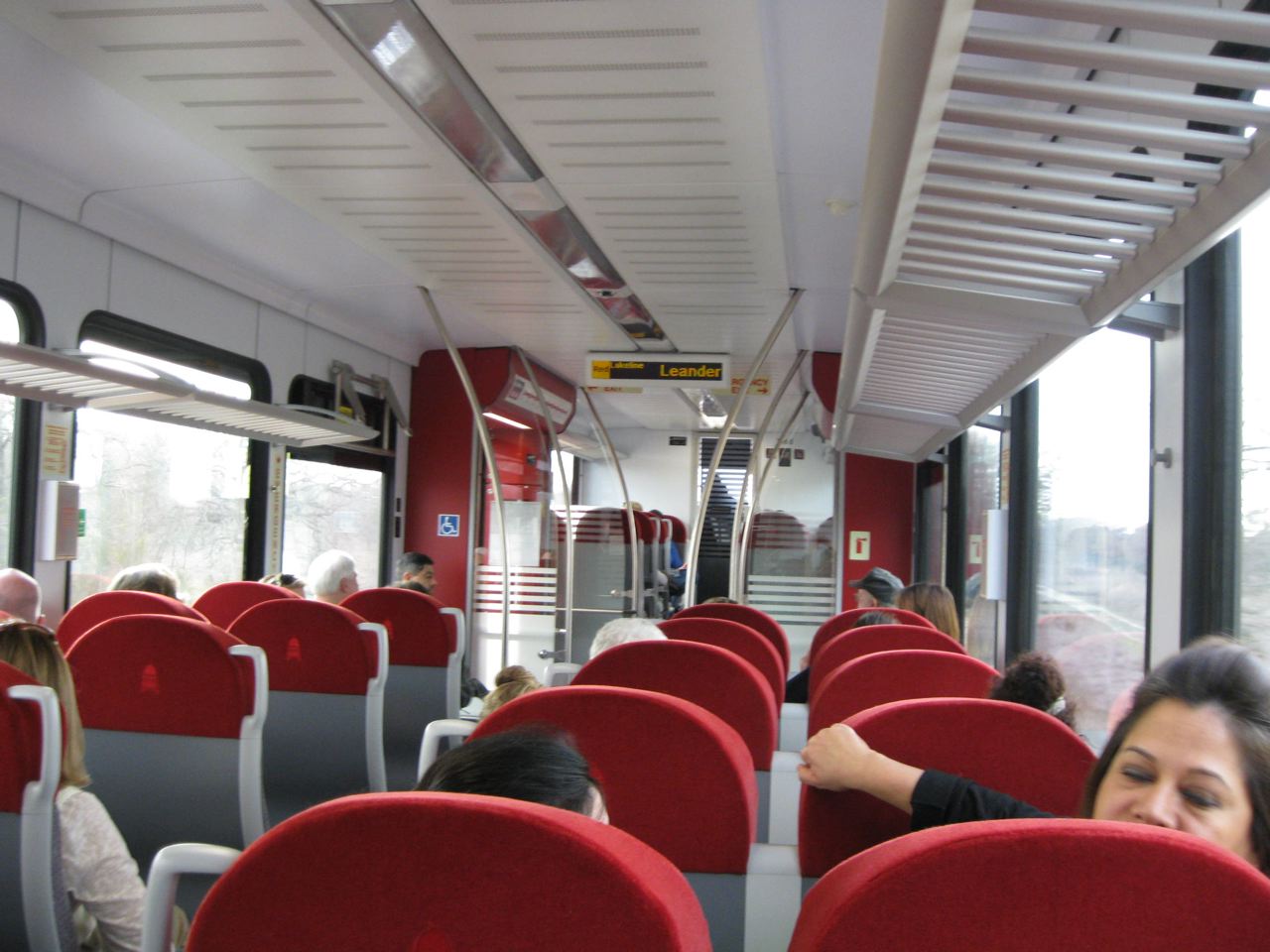 |
| At Leander, we chatted with the friendly crew, who invited us to ride the crossover move prior to the return. Chuck and Otto rode, but I chose to stay on the platform and take pictures, since the sunlight was full. We arrived at 4:47 and had until 5:22 until the southbound departure. |
 |
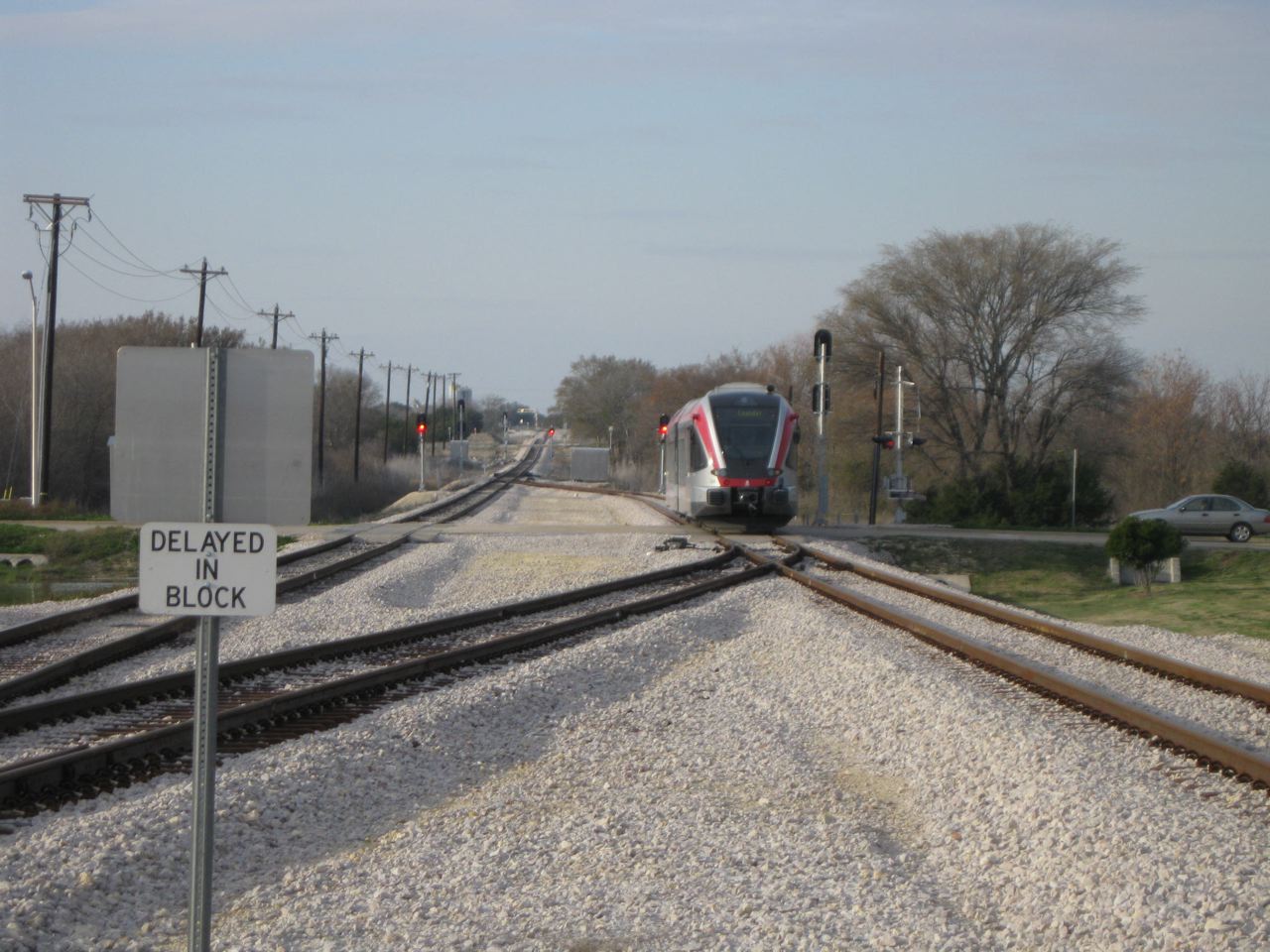 |
| Looking toward Austin at Leander. |
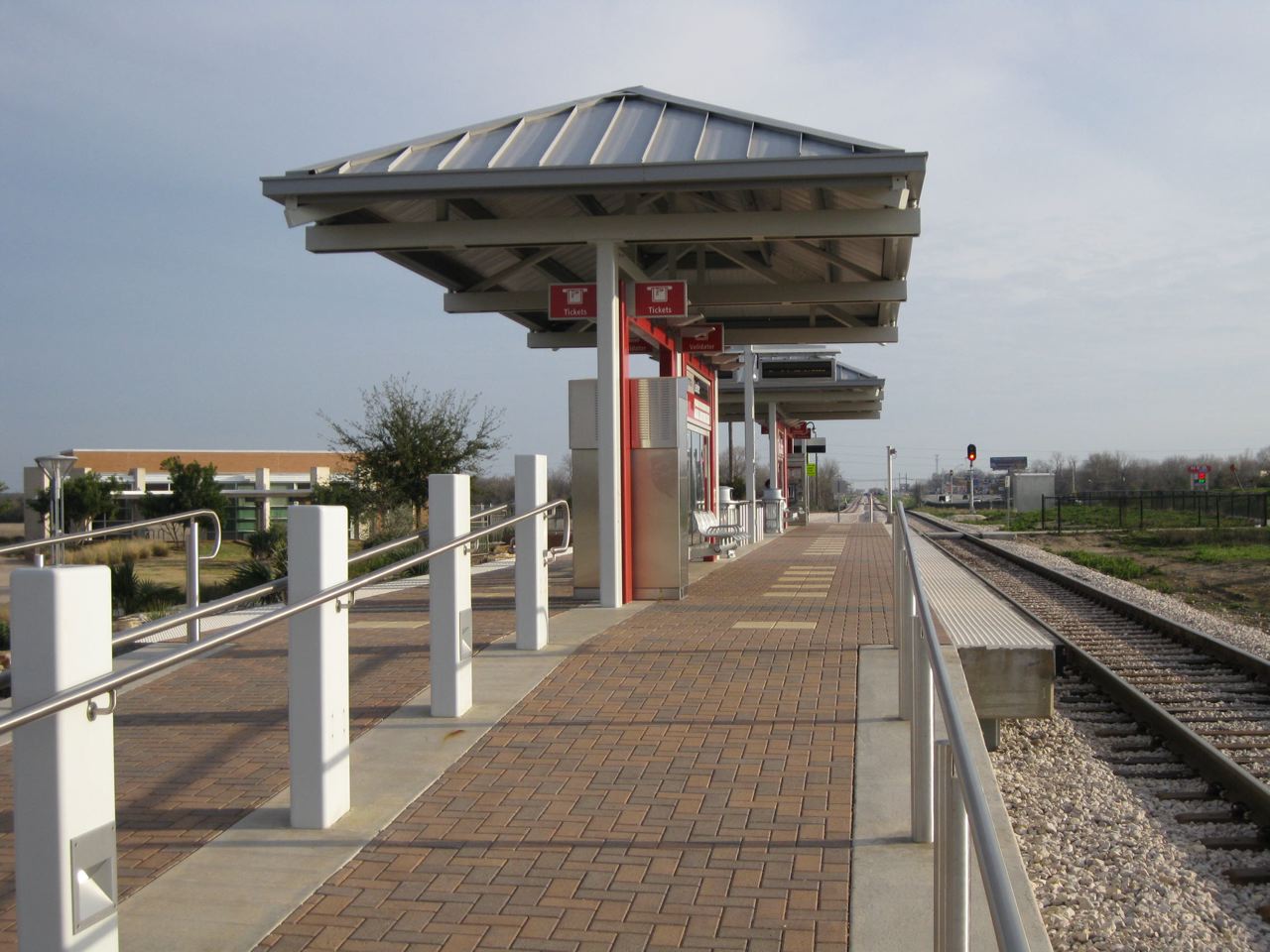 |
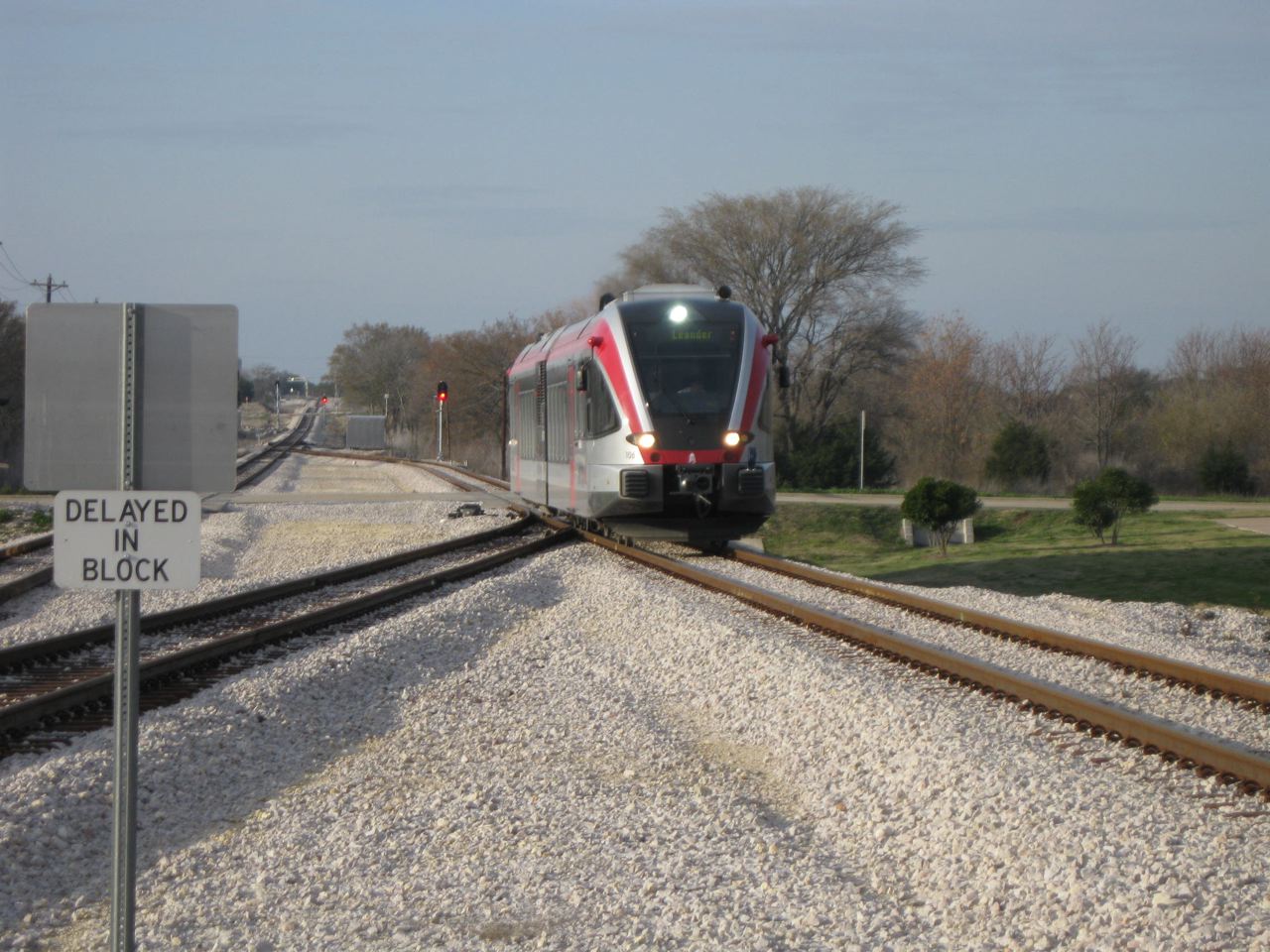 |
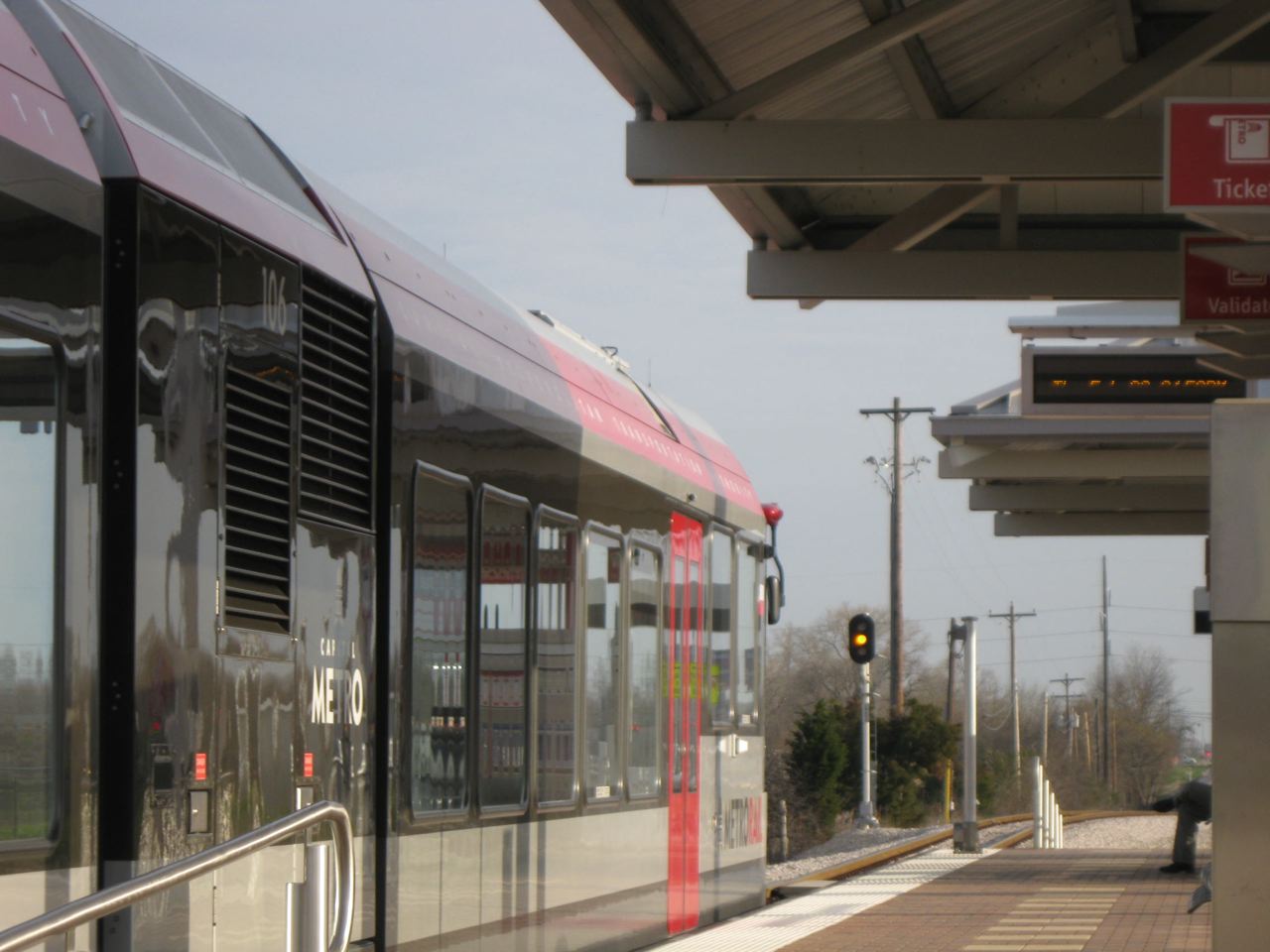 |
 |
| A thru-the-window view of the McNeil store, the Cap Metro flyover, and the shorline's freight main line track. |
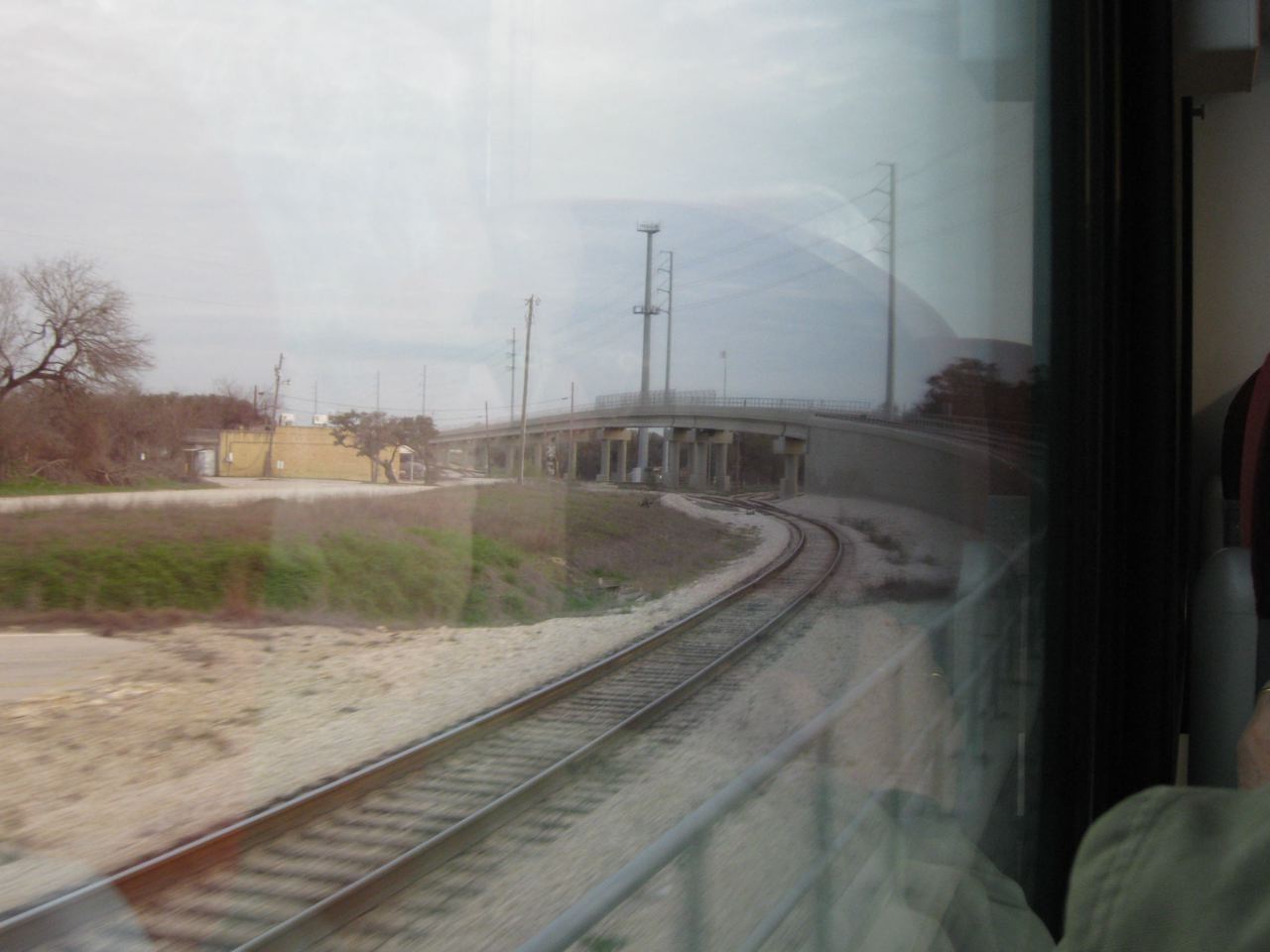 |
| A McNeil view north from the flyover. |
 |
| Best I could do with a grab shot of (half of) one of the two shortline units at its "facility" north of Howard. Looks like a GP50; another unit, not lettered for this road and in a RailAmerica scheme IIRC, was beyond it. This was the last photo of the day until we were in San Antonio, close to midnight at the Amtrak station. We fought Austin's rush hour on I-35 thru the city, dined in San Marcos, and had plenty of time to turn in the rental car at the San Antonio airport and taxi downtown to Amtrak to await the Sunset Limited for New Orleans. |
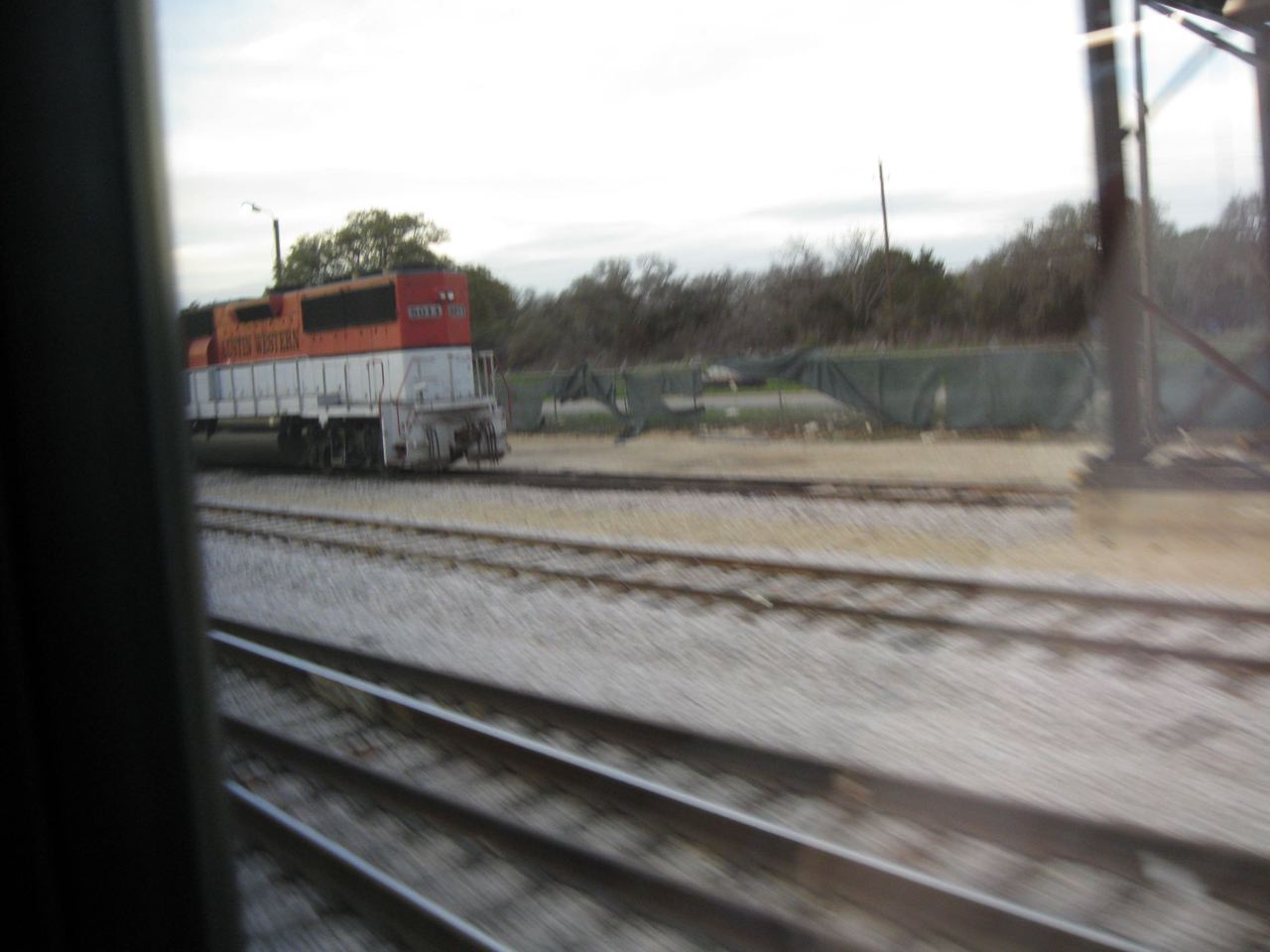 |
This page was designed and is maintained by Mike Condren. If you have materials
that you would like to contribute, contact me at mcondren@cbu.edu